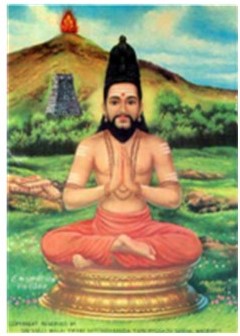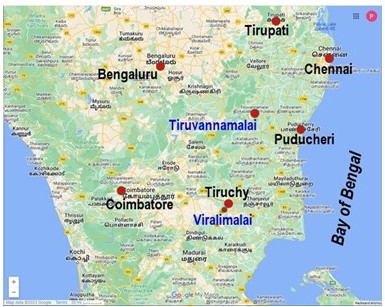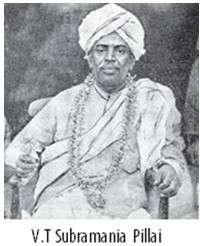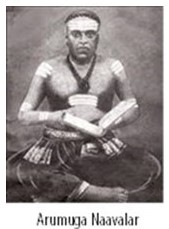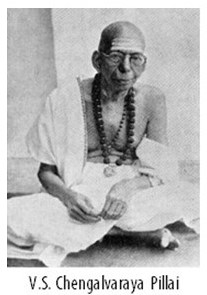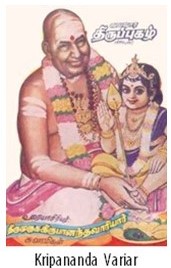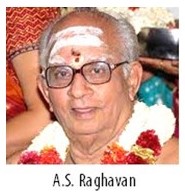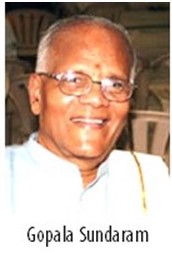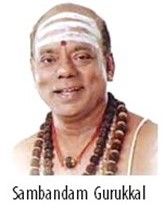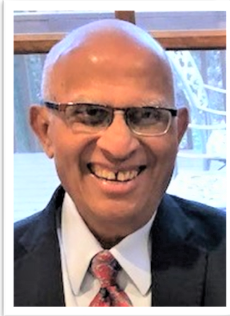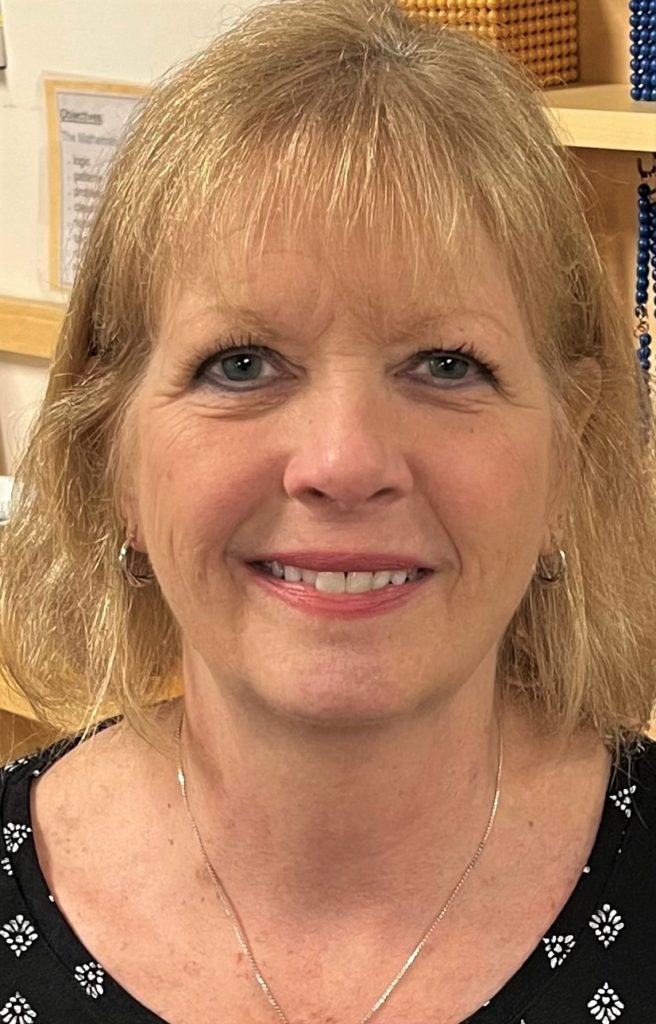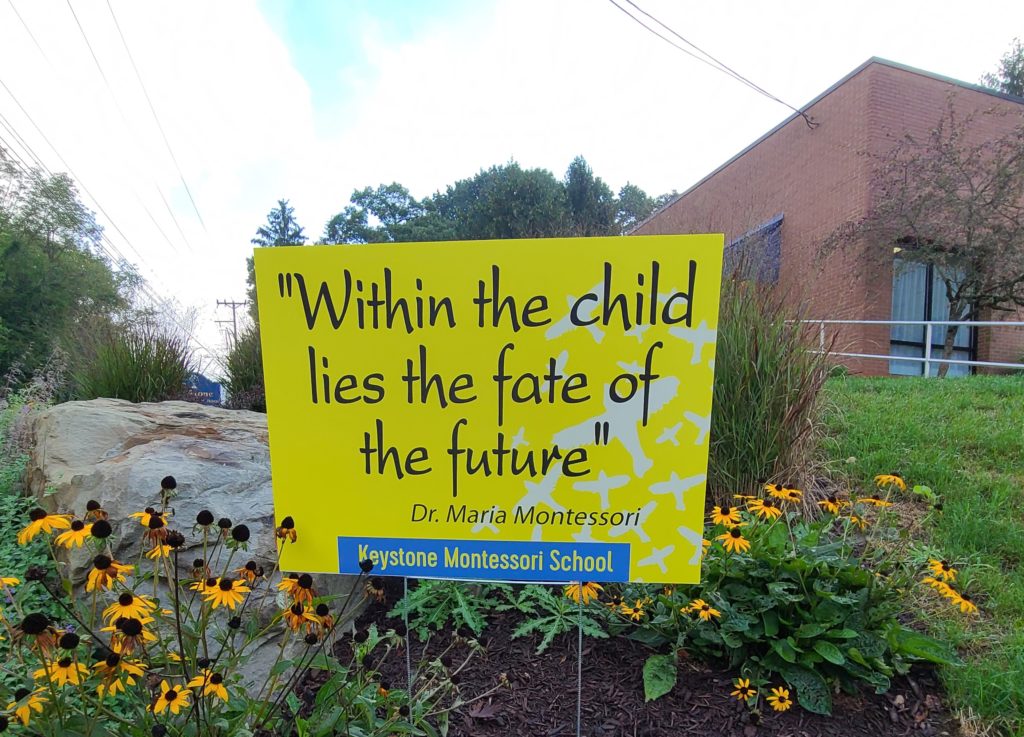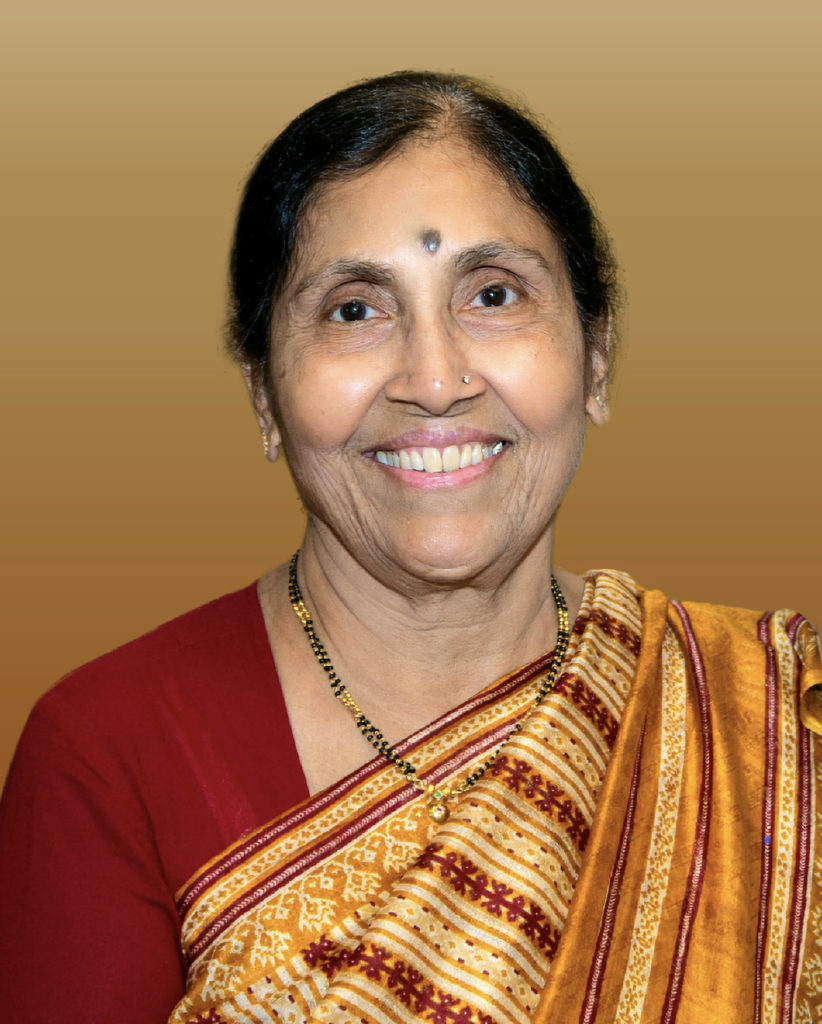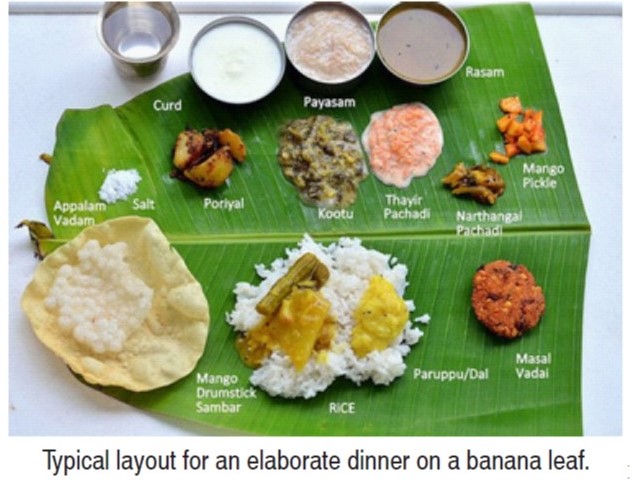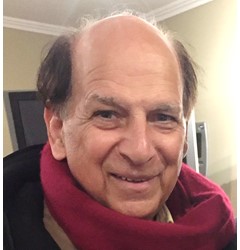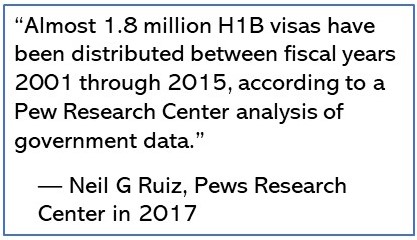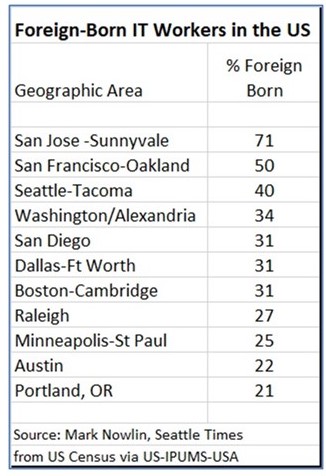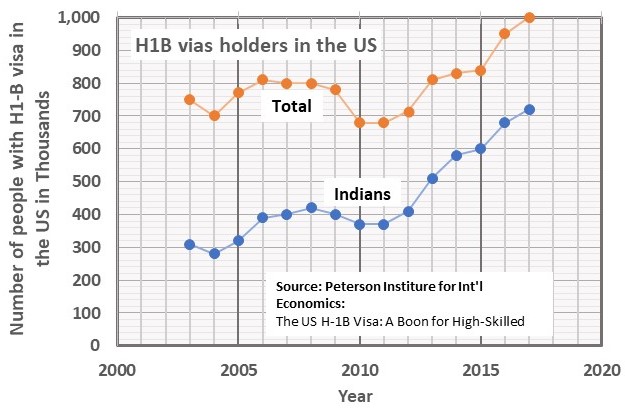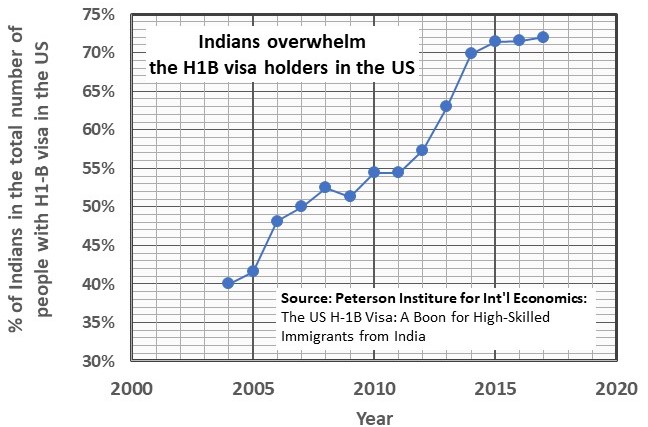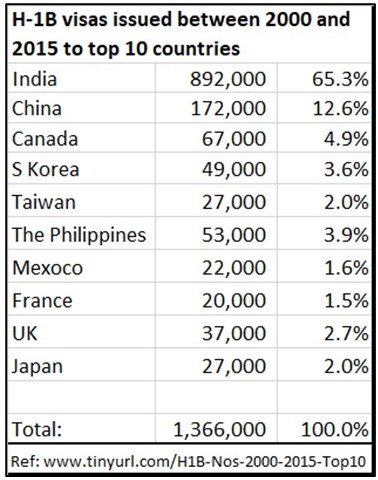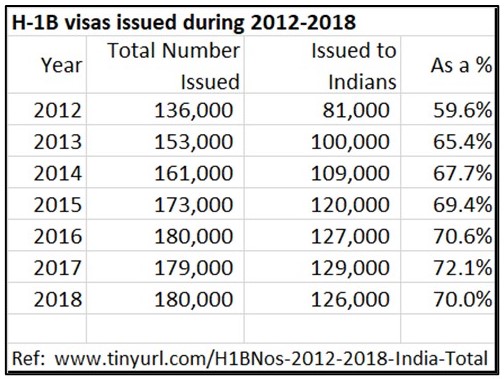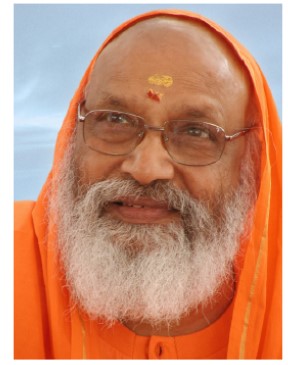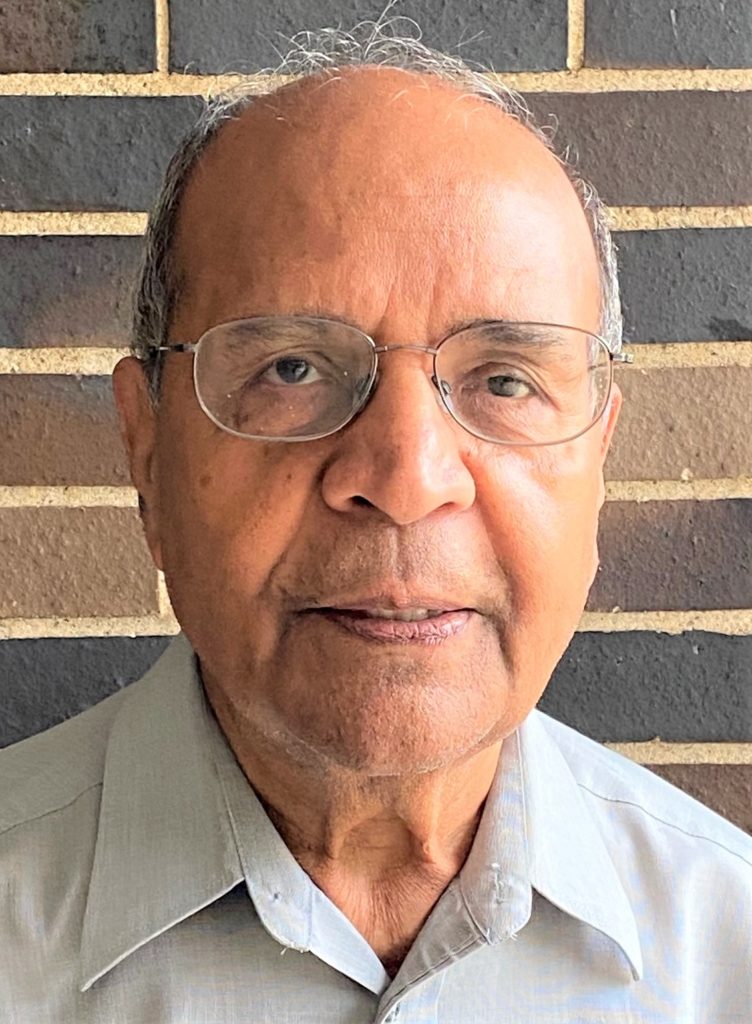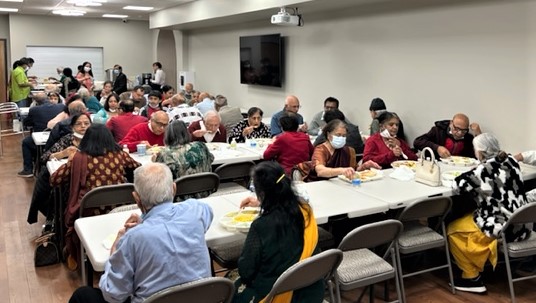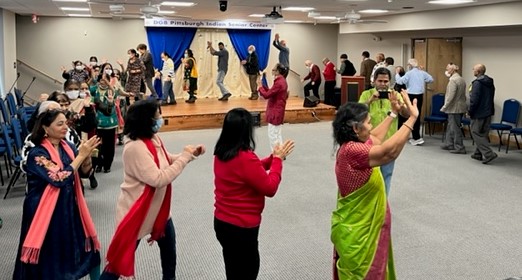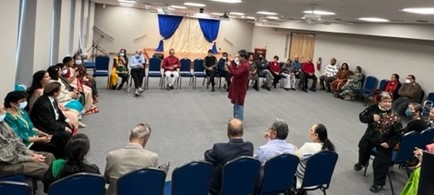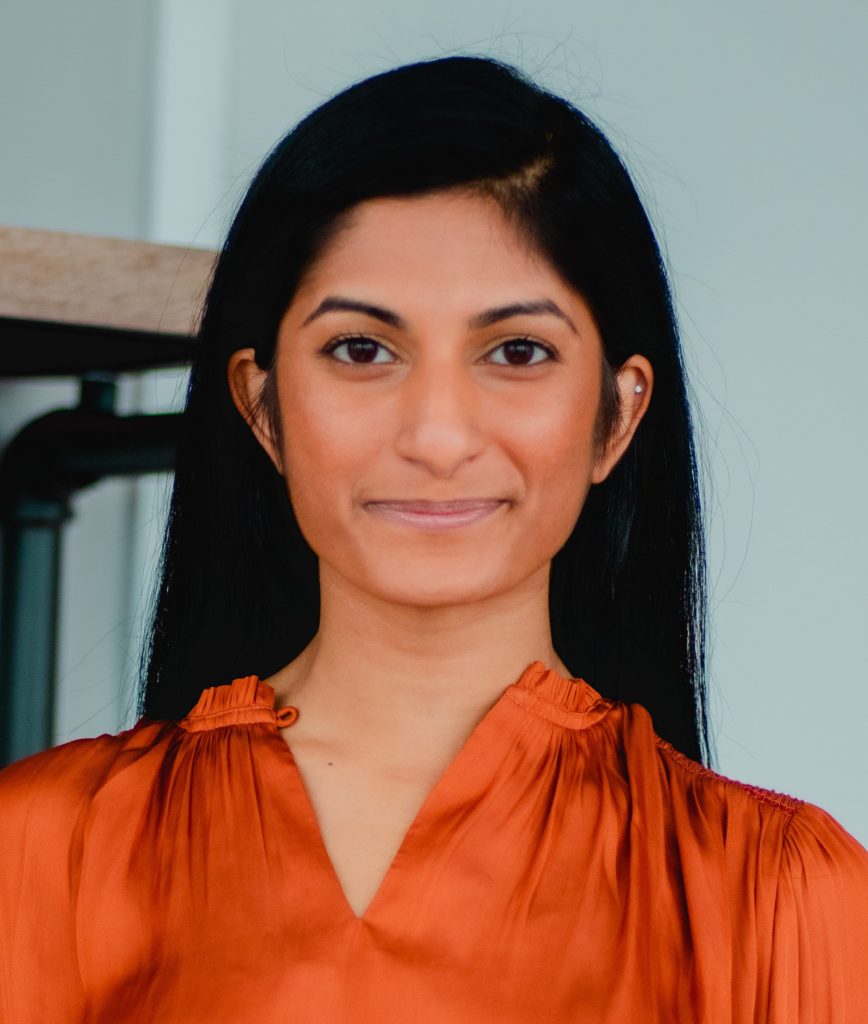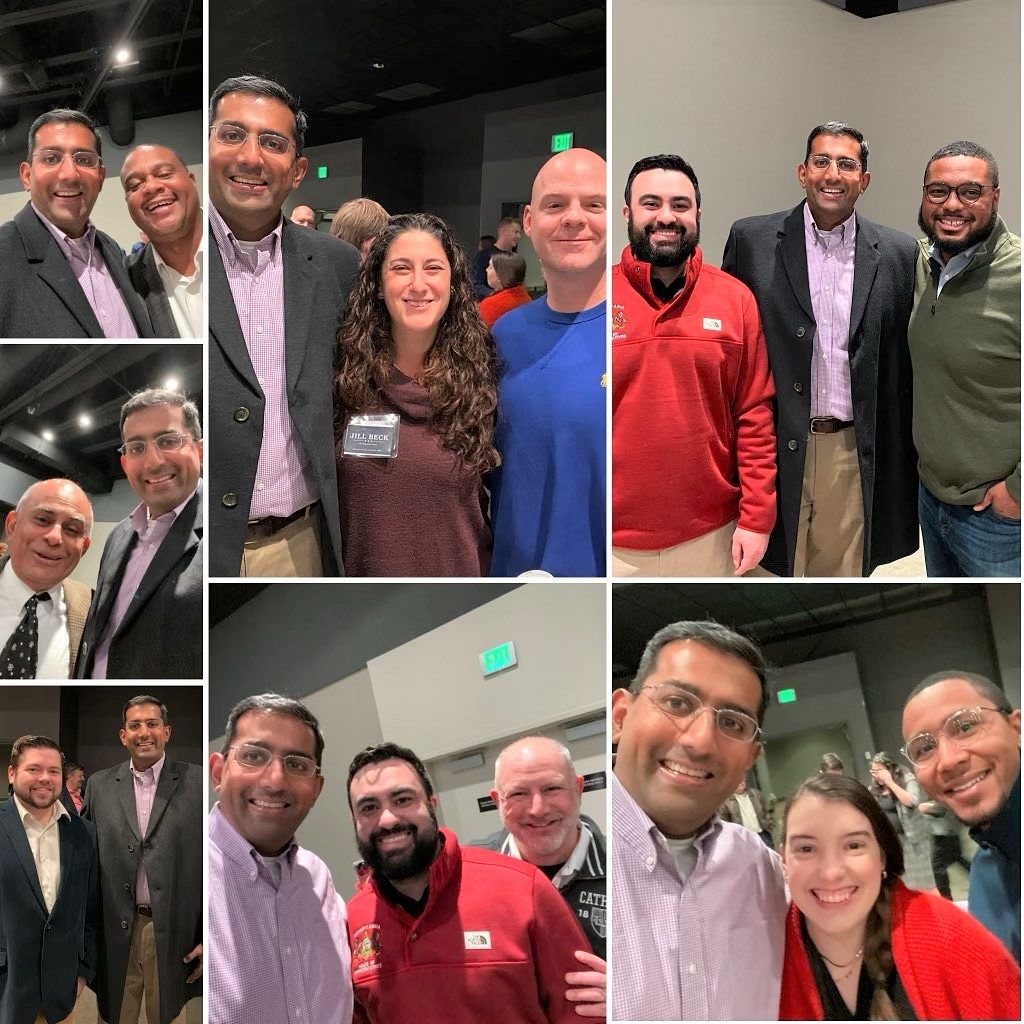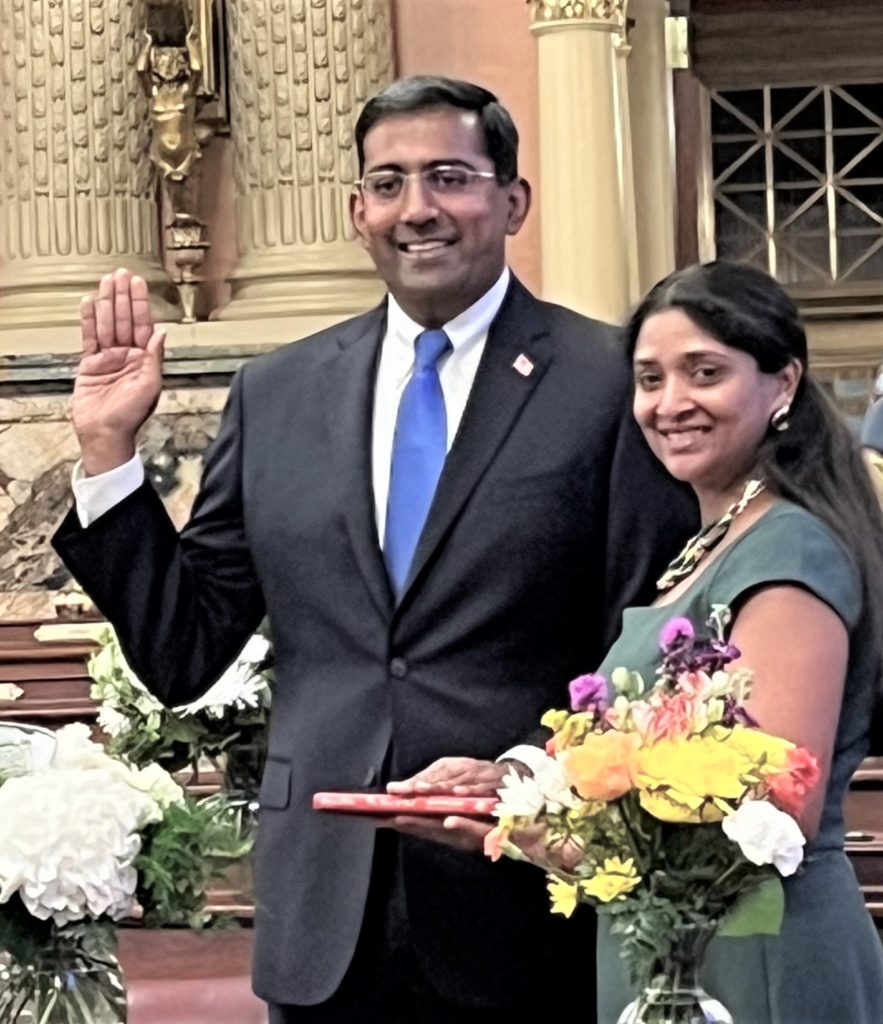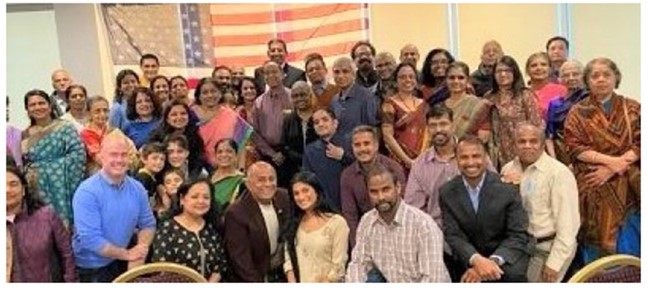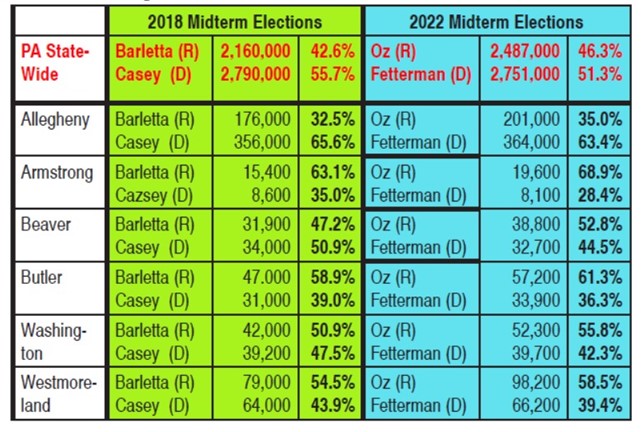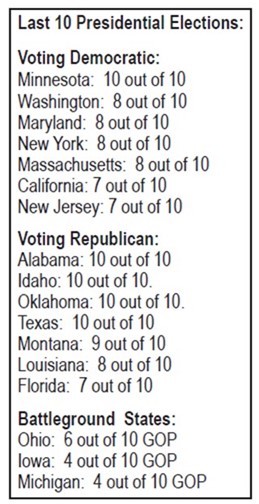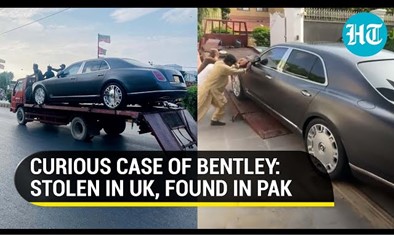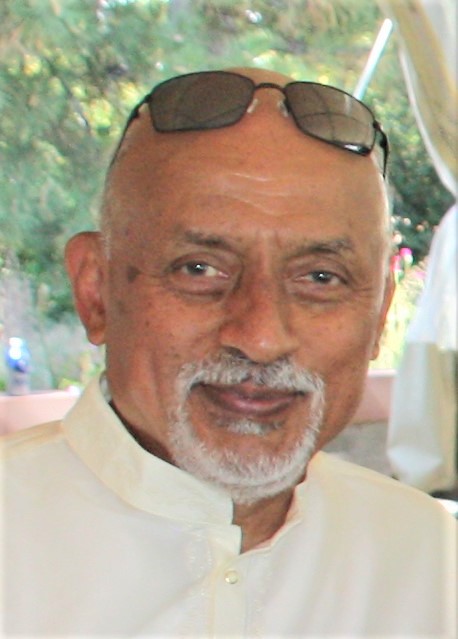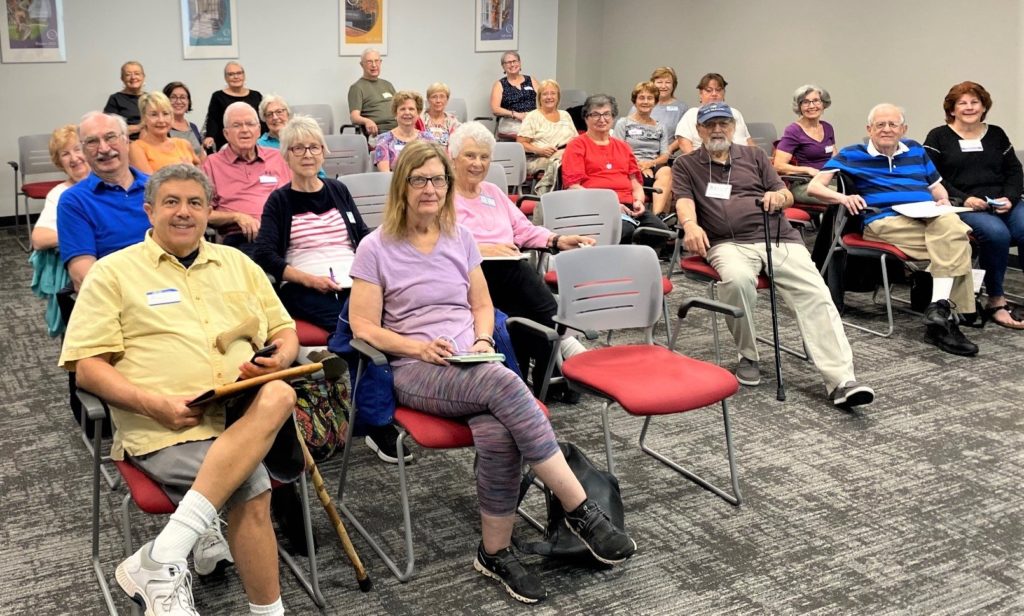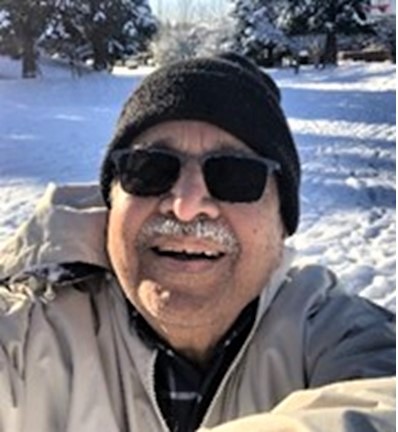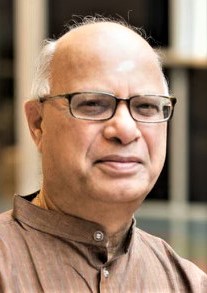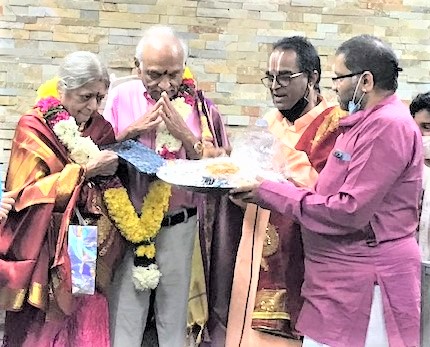Archive for category Past issues
Arunagirinaathar’s Life and Contribution to The Tamil Bhakti Literature
Posted by admin in January 2015 on May 30, 2023
By Kollengode S Venkataraman, Murrysville, PA
e-mail:ThePatrika@aol.com
Acknowledgments: M. Meenakshisundaram of Tiruchy, India for going over the drafts and offering valuable suggestions.
This article was written for the souvenir for Guha Ghosanam, a festival conducted in August, 2023 dedicated to Muruga-p-perumaan, at the Sri Siva Vishnu Temple, in Lahham, MD, a suburb of Washington DC.
In all faiths all over the world, admirers and devotees of great savants often add hagiographic embellishments to the lives of these sages, with some of these embellishments so fantastic that they confound rational minds. The admirers of Poet Arunagiri are no exception. His followers and devotees call him Arunagirinaathar (அருணகிரிநாதர், अरुनगिरिनादर), “nathar” a suffix added to his name out of their love and respect. This great Bhakti poet is known for his extraordinary poetical skills employing complex and varying rhythm patterns in his poems, his proficiency in Tamil and Sanskrit languages, and virtuosity in weaving into his poems the tenets of the Vedas, and stories from the Ramayana, the Mahabharata, and Siva, Vishnu, and Skanda Puranas. When you come to know of these, you too will admire him, and understand why his devotees call him Arunagirinaathar. Another unique feature in his poems is his mastery in trying to reconcile the conflicts between the Shaivites and Vaishnavites of his time.
Arunagirinaathar’s Time: His prolific religious-spiritual-poetical work was in the 15th century. He was born in 1370 Current Era and died in 1450 at the age of 80. He was born in the Sengunta Kaikolar community in Tiruvannamalai, the temple town for Arunachaleshawara in Tamil Nadu. In his poems, Arunagirinaathar refers to Prabhuda Devaraayan, the Vijayanagara king who ruled over the Tiravannamalai region in the 15th century, which confirms Arunagirinaathar’s time.
Arunagarinaathar’s life and lifestyle: In one of his poems starting with மனையவள் நகைக்க… … he describes his adult life, from which we can infer that he led a married life. From the structure and contents of his poems, there are strong reasons to believe that he lived close to temple dancers in the region. Living close to temple dancers — called Devadasis, a term not always used as a compliment — he saw in close quarters the lifestyles of the dancers living under the patronage of landlords and local kings. These dancers had to make many compromises in their lifestyles to live under such patronage.
In his poems the poet vividly describes the young dancers’ charm and beauty, the jewelry and clothes they wear, and the cosmetics and perfumes they use to enhance their beauty.
In over 1600 of his poems, Arunagirinaathar candidly acknowledges his proclivity for excessive indulgence in sensual pleasures. Recognizing this, he pleads for Muruga-p-peruman’s (literally, Lord Muruga’s) grace to wean himself away from this weakness.
In all societies throughout history, in people given to excessive indulgences of all types, we see radical transformations taking place quite abruptly. As if by a miracle, people voluntarily and without any struggle walk away from their lifestyle given to excesses. We hear about people among us making these kinds of abrupt U-turns in their lives — some of us even know them personally. When we ask them how they changed so suddenly, they struggle to explain the changes using logic. They attribute the abrupt changes for the better in their lives to Divine Intervention, or God’s Grace (இறைவன் அருள்).
Such a miraculous transformation happens to Arunagiri also, who was given to a profligate lifestyle. Recognizing this, he feels so despondent about his situation, as the popular story of his life goes, that he wanted to kill himself by jumping off a smaller Gopuram in the Arunachaleshwara Temple complex in Tiruvannamalai. As he was about to jump off the tower, he was miraculously stopped by Muruga-p-perumaan (Lord Muruga) Himself, telling him, “Your life is not to be wasted, and your mission is to save the lives of fallen people.” When Arunagiri pleaded how he can do it given his background, Muruga-p-perumaan (Lord Muruga) gives him the first phrases, முத்தைத்தரு பத்தித் திருநகை (Muththai-tharu-paththi-thirunagai) and disappears.
With the grace granted by Muruga-p-perumaan, Arunagirinaathar spontaneously composes his first song right there. You can listen to his first verse here:
www.youtube.com/watch?v=Fp7VAfmxJog,
and listen to Sambandam Gurukkal rendering the song in pulsating and lilting rhythm.
This was a great transforming moment in Arunagirinaathar’s life. He effortlessly abandoned his reckless lifestyle, becoming a mendicant and an ardent devotee of Muruga-p-perumaan. He later traveled all over South India and Sri Lanka, visiting over 200 Siva and Murugan temples, and composed songs addressing their presiding deities. Over 1600 poems are available in an anthology called திருப்புகழ் (Tiru-p-pugazh), meaning Divine Praise, most of them addressed to Muruga-p-peruman.
Arunagirinaathar’s poems in Tirup-pugazh are known for their lilting and pulsating complex rhythm patterns, known in Indian prosody as Chandas (छन्दस् in Devanagari, and சந்தம் in Tamil), meaning poetical meter. His poems are usually four- or eight-line verses consisting of 6, 8, 10, 12, 14, 16, or even 20 phrases in each line conforming to complex rhythm patterns. The poet keeps the same complex rhythm pattern in all the four or eight lines in each poem. This alone requires great linguistic skills purely in terms of prosody.
For example, his most popular poem muththai-tharu-paththi-thirunagai (முத்தைத்தரு பத்தித் திருநகை அத்திக்கிறை சத்திச் சரவண… …) follows the following rhythm pattern.:
tatta-tana tatta-tana-tana tatta-tana tatta-tana-tana
tatta-tana tatta-tana-tana — tana-taana
தத்த-தன தத்த-தனதன தத்த-தன தத்த-தனதன
தத்த-தன தத்த தனதன –– தனதான
Many Tamils know the name Tiru-p-pugazh, or at least would have heard the name. Not many would have read the verses or grasped their meanings. The verses have complex tongue-twisting phrases mixed with Tamil and Sanskrit words, written following Tamil and Sanskrit sandhi rules. This is difficult to grasp, especially for today’s Tamils with a limited knowledge of the Tamil language and its vocabulary because of the neglect of the Tamil in the school curriculum.
What is remarkable about Arunagirinaathar is that his skills in using complex rhythm patterns are only the base frame of skeleton in his poems. Around this frame, the poet builds complex stories giving us sensuous poems dripping in Bhakti (devotion). To fully understand and appreciate Arunanagirinaathar’s poems, one needs a good grasp of Tamil and Sanskrit vocabulary and grammar to get their basic meanings; and also to know of Sanatana Dharma’s tenets in the Vedas, Puranas, Ashtanga Yoga… … as we discussed earlier.
So, without the help of commentaries from scholars, it will be very difficult to understand and admire the prosodic skills of Arunagirinaathar and his grasp of all facets of the Sanatana Dharma. Here is a two-line example, first in the original form with the words fitted to flow with the rhythm pattern, and then with the words split to get some idea of what the poet conveys:
Rhythm pattern:
தாத்தனத் தானதன தாத்தனத் தானதன
தாத்தனத் தானதன …… தனதான
Original lyrics:
வாட்படச் சேனைபட வோட்டியொட் டாரையிறு மாப்புடைத் தாளரசர் …… பெருவாழ்வும்
மாத்திரைப் போதிலிடு காட்டினிற் போமெனஇல் வாழ்க்கைவிட் டேறுமடி …… யவர்போலக்
With words split for getting the meaning:
வாட்படச் சேனைபட ஓட்டி ஒட்டாரை
இறுமாப்புடைத்து ஆள் அரசர்… … பெருவாழ்வும்
மாத்திரைப் போதில் இடு காட்டினிற்
போமென இல் வாழ்க்கைவிட்டு ஏறும்… … அடியவர்போல
In these poems Arunagirinaathar openly and candidly pours out his proclivity to excessive sensual gratifications. He pleads for Muruga-p-peruman’s grace to wean himself away from his weakness, and move him towards the sublime. In his verses, Arunagirinaathar uses first-person singular, indicating his own personal struggle. When we read these poems constructed in first-person singular, we often feel that Arunagirinaathar is describing our own personal struggle on these matters.
A Unique Feature of Arunagirinaathar’s Poems: The schism between the Saiva and Vaishnava schools of worship in the Tamil country through the centuries is well known and there is no need to gloss over this division. Given this atmosphere, Arunagirinaathar is unique in the Tamil Bhakti literature.
Muruga-p-peruman is the son of Siva and Parvathi; with Parvathi being Vishnu’s sister, Murugan is also the nephew of Vishnu and Lakshmi.
Arunagirinaathar uses this puranic fact quite brilliantly and unabashedly in many poems. He would describe Muruga-p-perumaan as the son of Siva; and in the next breath and in the next line, as the nephew of Vishnu. Here is an example:
“O the Crimson-Colored (செய்யோய், a descriptive name for Muruga-p-peruman), the son of the One Who Wears Snakes as Garlands (reference to Shiva), and the nephew of the One Who Sleeps on the Bed of a Snake (reference to Vishnu), please grant me Your Grace.”
There are hundreds of references like this in his poems in which the poet refers to Lakshmi, Parvathi, Rama, Krishna, Arjuna, Ravana, Hanuman, Ganesha, and weaves episodes in the Ramayana and Mahabharata and the puranas into his poems. Why he did this in the 15th century is an interesting question for all of us to ponder over and see its relevance in the 21st century, here in the US.
How Arunagirinaathar’s poems were unearthed is a fascinating story. Arunagirinaathar’s contribution to Tamil literature in general, and Tamil Bhakti literature in particular, will be incomplete without the contributions of these great men:
V. T. Subramania Pillai (1846 – 1909): Till the late part of 19th century, Arunagirinaathar’s poems were not known to most people in Tamil Nadu. They were on palm leaves in homes of people in and around Tiruvannamalai and the Kaveri Delta area.
One Shri V. T. Subramania Pillai, a District Munsiiff and Judicial Officer under the British, in 1871 went to resolve a dispute at the Chidambaram Temple; the Temple’s Deekshitars quoted several verses from old Tamil bhakti poetry to make their claims. One such poem the Deekshitars quoted was from a verse of Arunagirinaathar. Fascinated by this verse, Subramania Pillai, a devotee of Muruga-p-peruman, wanted to know more about the person who wrote the poem, and he came to know of Arunagirinaathar. This started Subramania Pillai’s search for Arunagirinaathar’s poetry. He came to know of the sage’s six poems in a book by the great scholar Arumuga Naavalar (1822-1879), who lived in Jaffna, Sri Lanka.
Arumuga Naavalar’s contribution to preserving Saivism among the educated Tamils in Sri Lanka is considerable during the Portuguese and Dutch colonial occupation of Sri Lanka.
Starting with the six poems found in Arumuga Naavalar’s book, Shri Pillai went about his mission in his search for Arunagirinaathar’s works, said to be over 16,000 poems. He ended up collecting from various sources over 3,000 verses on palm leaves. He spent considerable time in sorting out his palm leaf collections, removing duplicates (which confirmed to him the authenticity of Arunagirinaathar’s works) and reconciling the same poems with different similar sounding words here and there. He and his sons Chengalvaraya Pillai and Shanmugam Pillai spent considerable amount of their time and personal resources in bringing out Arunagirinaathar’s poems in three volumes in the late 19th century and early 20th century. The Tamil literary World owes a great deal to V. T. Subramania Pillai and his two sons for bringing out Arunagirinaathar’s works for the outside world.
Kripananda Variar Swami (1906-1993): We owe a great deal to Kripananda Variar for painstakingly writing in six volumes detailed commentaries the Tiru-p-pugazh songs, giving word-by-word meaning and explaining the references to all the stories in the songs. This monu-mental work is necessary for anyone wanting to understand the nuanced meanings of the Tiru-p-pugazh verses in the context of Tamil Bhakti literature. Variar Swamy gave countless upanyasams and discourses on Tiru-p-pugazh all over the world. Incidentally, Variar Swamy was the inspiration for the Murugan Temple in Lanham, MD.
A. S Raghavan Sept 4, 1928-May 17, 2013), a government official in New Delhi, was so deeply impressed with Tiru-p-pugazh that he started a bhajan group in New Delhi. This grew over the years with people who learned from him the songs starting local chapters of Tiru-p-pugazh bhajans wherever they settled, including in the US. His group called Tiru-p-pugazh Anbargal (Friends of Tiruppugazh) set up branches in many parts of India and even outside. Details here: https://www.lokvani.com/lokvani/article.php?article_id=9938
For people with a decent grasp of the Tamil language and the basic tenets of the Sanatana Dharma, a very good source for Tiru-p-Pugazh songs and their general meanings is the website developed by Shri Gopala Sundaram at www.kaumaram.com/thiru/nnt0663_u.html. Gopala Sundaram’s website catalogs Arunagirinaathar’s Tiru-p-pugazh songs alphabetically, and also in terms of the temples on which the poems were composed.
You can listen, enjoy, and admire Arunagirinaathar’s complex rhythm patterns in Shri Pondicherry Sambandam Gurukkal’s excellent recordings of Tiru-p-pugazh songs here:
www.tinyurl.com/Sambandam-Gurukkal-1
www.tinyurl.com/Sambandam-Gurukkal-2
Shri Sambandam Gurukkal brings out the life in Arunagirinaathar’s verses with his grasp of Tamil Bhakti literary tradition and musical training.
Arunagirinaathar’s complex meters, Sanskrit and Tamil phrases, and descriptive names for deities in his poems are impossible to poetically translate into English or other European languages; and perhaps even into South Indian languages.
Fred Clothey, who was born to missionary parents in the Tamil country in the early 20th century, is the Professor Emeritus of Religious Studies at the University of Pittsburgh. He spent over 15 years in India, and also worked in Malaysia and Singapore. Clothey introduced Arunagirinaathar to English-speaking readers in his scholarly book Quiescence and Passion (now out of print), focusing on Kandar-Anubhuti and Kandar-Alankaaram. On the difficulty of translating Arunagirinaathar Clothey says:
“[My work] is a classic example of the kind of project into which fools rush where angels fear to tread. Neither my English nor Tamil qualifies me to translate poetically a Tamil poet who remains defiantly untranslatable… … [I got introduced to Arunagiri] in 1965 and sampled the poet’s unusual style. I have since come to know even better why none have dared to attempt a translation [of Arunagirinaathar] save in the most prosaic of ways.”
Tamil scholars in the 19th and 20th century who brought this great poet’ work to public attention are: The Tamil poet Pamban Swamigal (1848 -1929); The scholar-writer Vannasarapam Dhandapani Swamigal (1839 – 1898); A.S.Subramanian known as Thiru-p-pugazh Tha-tha; and Ki. Vaa. Jagannathan (1906-1988).
Arunagirinaathar left his mortal remains when he was 80 years in Tiruvannamalai. Every year in July the Murugan Temple in Viralimalai, (situated 18 miles southwest of Trichy in Tamil Nadu) organizes a music festival honoring Arunagirinaathar.
Arunagirinaathar life story is so captivating that the Tamil film industry made a full-length feature film Arunagirinaathar with the famous playback singer T.M. Soundararajan as the poet Arunagirinaathar. And the Government of India released a postage stamp (INR 50 denomination) in Arunagirinaathar’s honor. Arunagirinaathar’s other works:
• கந்தர் அனுபூதி Kanthar Anubhuthi – 51 verses, each four lines, with four phrases/line.
• கந்தர் அலங்காரம் Kanthar Alangaaram – 107 verses each four lines, with five phrases line
• கந்தர் அந்தாதி Kandar Anthaathi – 100 verses, each four lines, with five phrases/line.
• திருவகுப்பு Thiru Vaguppu
• வேல்விருத்தம் Vel Virutham – 10 verses each four lines, with twelve phrases/line.
• மயில் விருத்தம் Mayil Virutham – 11 verses each four lines with twelve phrases/line.
• சேவல் விருத்தம், Seval Viruttam and –11 verses each four lines with twelve phrases/line.
Arunagirinaathar’s expansive, enigmatic, and in-scrutable idea of Godhead, we can see in the last verse in Kandhar Anubhuthi:
உருவாய் அருவாய், உளதாய் இலதாய்
மருவாய் மலராய், மணியாய் ஒளியாய்க்
கருவாய் உயிராய்க், கதியாய் விதியாய்க்
குருவாய் வருவாய், அருள்வாய் குகனே.
Fred Clothey translated the above terse verse into English, capturing the great poet’s cryptic style in his English translation as well:
Formed, Formless; Being, Non-Being;
Flower, Fragrance; Jewel, Radiation;
Embryo, Life; Goal, Way;
Come Guha, [as my] Guru
[and] Grant [me] your Grace.
Arunagirinaathar’s devotees organize festivals for him periodically at the Tiruvannamalai temple and Murugan temples in India, and in Hindu Temples in Mauritius, Malaysia, Singapore, Sri Lanka, Australia, and North America.
After this discursive discussion, it may be appropriate to end this write-up by quoting a great terse phrase in Arunagirinaathar’s Kandar-Anubhuti, in which the poet recalls the advice Muruga-p-peruman gave him:
சும்மா இரு, சொல் அற,
literally meaning “Be Still, and Speak Not,” or better still, “Keep Quiet and Chatter not.”
It is worth noting that both Thaayumaanava Swamy (1705-1744) and Ramana Maharshi (1879-1950) adopted these phrases in their philosophical/spiritual works. And that is a delightful way to end this write up on the One-of-a-Kind Great Tamil Bhakti poet, Arunagirinaathar.
References:
1. Clothey, Fred, Quiescence and Passion, Publishers: Austin & Winfield, San Francisco, 1996, 177 pp. (now out of print, but available in a few bookstores and on-line book outlets.)
2. www.eng.arunagirinatharmanimandapam.org/scholars-of-tirupugazh/
3. Kripananda Variar, Tiru-p-pugazh Virivurai, in six volumes, Publishers: Vaanathi Pathippagar, T.Nagar, Chennai, 1985 onwards.
4. www.kaumaram.com/thiru/nnt0663_u.html.
5. www.tinyurl.com/Sambandam-Gurukkal-1
6. www.tinyurl.com/Sambandam-Gurukkal-2
__________________________________________
About the author: Kollengode S. Venkataraman, lives in the Pittsburgh metro area since mid1980s, and is the editor and publisher of a 28-year-old independent quarterly magazine, The Pittsburgh Patrika, (www.pittsburghpatrika.com).
Obituary: Vinod B Doshi, Beloved Husband, Cherished Father & Grandfather, Distinguished Engineer and Founding Member of the Hindu-Jain Temple (1936 to December 11, 2022)
Posted by admin in April 2023, Past issues on March 30, 2023
Vinod B. Doshi, age 86, our father, passed away peacefully on Sunday, December 11, 2022, surrounded by his loving family. He was 86. He was born in Calcutta, India, on October 8, 1936 the older of two children to the late Shri Babulal and Smt. Chabalben Doshi.
He and his late wife and our mother Indu were married for 52 years and the proud parents of three children and six grandchildren: Anita Doshi Carleton (son-in-law Dennis, grandchildren Neil and Kellen); Salil Vinod Doshi (daughter-in-law Bijal, grandchildren Shay and Reveen); and Nisha Doshi Westerman (son-in-law David, grandchildren Pria and Cole).
He graduated from the most prestigious engineering college in India, the Indian Institute of Technology, and he enjoyed a rewarding career at Westinghouse and Siemens designing power generation systems and was an inventor on many patents. He was passionate about the Indian community in Pittsburgh and was instrumental in its growth, serving as a founding member of the Hindu-Jain Temple.
He was the president of the Jain Society of Pittsburgh, co-convener of the JAINA Convention in Pittsburgh, active in JAINA (Federation of Jain Associations in North America), and instrumental in establishing the Gujarati Samaj in Pittsburgh.
He enjoyed travel all across the globe with his wife, children, and friends over the years. He loved passionately cheering for the Pittsburgh Steelers, Penguins, and Pirates.
A traditional Jain Funeral Service was held for our father on Sunday, December 18 at the Beinhauer Funeral Home in Dormont, PA. Pandit Suresh Chandra Joshi from the Hindu-Jain Temple guided our family with the Jain cremation rites. After the funeral service, a Celebration of Life Luncheon was held at the Hindu-Jain Temple Hall. ∎
Obituary: Vijaya Rao, An Affable Early Indian Immigrant and Silent Volunteer at the S.V.Temple (1942 to February 19, 2023)
Posted by admin in April 2023, Past issues on March 30, 2023
Vijaya B Rao, a long-time resident in our area, wife of the late Raja B Rao, of Penn Hills, PA passed away peacefully on Sunday February 19, 2023 with her loving family by her side. She lived in Penn Hills for decades before moving into hospice care towards the end.
Vijaya came to this country in 1967 along with her husband Raja Rao, who was teaching statistics at the University of Pittsburgh, and young son. She and her husband were able to create a lively life for themselves and their two children. They always kept their faith and roots to India very close to their heart.
In 1976 when the concept of a Venkataswara temple was first mooted by their friends, Vijaya and Raja Rao were quite excited to join the cause. The temple became a community they immersed themselves in. It became for them a home away from their home in India. She and her husband were long time members of the temple where they spent countless hours as devotees and volunteers. They took keen interest in the music and dance programs organized at the temple in those early years.
Vijaya also enjoyed spending time with her family and friends. She was well known among her friends as an excellent cook and a reliable friend. She also enjoyed playing with her dog grandchildren, Cody, Ellie, Lucy & Coco.
At the request of Vijaya, her family conducted a private funeral and cremation ceremony following Hindu traditions at the Beinhauer Funeral Home on West Liberty Ave, Dormont.
Left to cherish Vijaya’s memory are her son Harish Rao, his wife Swati of Dallas, Texas; her daughter SriDevi Rao James and her husband Mark James of Oakdale, Pennsylvania; and her grandsons Anish and Anjay Rao and her granddaughter Taylor James as well as several nieces and nephews here and in India. After the death of her husband Raja B Rao in 2001, she lived independently with the continuous support of her daughter Sridevi, who is in the nursing profession.
A special thanks to the Celebration Villas and Bridges Hospice as well as her close friends who provided excellent care and her favorite Indian dishes. — By a friend of Vijaya Rao ∎
Montessori Pre-School in Monroeville Helps Children to Naturally Acquire Learning Skills
Posted by admin in April 2023, Past issues on March 30, 2023
By Sandra Durkin, Mars, PA
Editor’s Note: Ms. Sandra Durkin is a 28-year veteran consultant in early childhood education. Her background has been in psychology (LaRoche University) and American Montessori Society’s Early Childhood Teaching (Carlow University). With Pennsylvania Teaching Certification and active participation in several leadership programs, Sandra owned and ran the state-licensed Garden Montessori School in Cranberry Township from 1999-2020 with 65 children, offering extended care, enrichment camps, Spanish, and summer camps.
Keystone Montessori School in Plum Boro has been offering multi-age Montessori programs in the Monroeville area for over fifteen years, serving children from ages twenty months through kindergarten. Three age groupings in the school enable each child to stay with the same teacher, with the academic year running from September through May, and half-day camps continuing through the summer. The school is located at 3245 Old Frankstown Road, Plum, close to Business 22 and the PA Turnpike.
Owner-Administrator Linda Franke has designed the Montessori program with adequate resources at her school to meet the needs of the children, as well as the needs of families. Her lifelong work and commitment to Montessori education is summed up by her favorite quote: “Teach children to learn to do it by themselves.”
When children begin this unique experience at twenty months, they are eager for independence, and the PROCESS of learning gets instilled in a natural learning environment. They seek more challenges, observing and learning from older children.
Keystone classrooms offer several carefully selected hands-on activities for each child to build a foundation for concrete learning. Dr. Montessori’s famous quote “The hand is the teacher of the mind” is an all-encompassing summary of the core of the philosophy at Linda’s school. Montessori believed that the most important period of learning occurs from birth to age six through the “Absorbent Mind,” what people often refer to as children being like “sponges.”
The environment at the Keystone School utilizes activities in practical life, sensorial experiences, language, phonics, math, and geography, with certified Montessori teachers designing the enticing activities, increasing in difficulty with each step. The children actively engage in worldwide cultural experiences through participation of multicultural families of the children in the school.
Children progress individually at their own pace, based on their natural instincts, and skills they develop and master in the class room. The older children can teach, lead, and serve as role models, which increases their self-esteem and confidence.
The Keystone Montessori School offers Peace Education and conflict resolution in its curriculum, incorporating the “Peace Rose” and daily practice of the virtues of good behavior. The children demonstrate their understanding polite interactions with their peers in the class.
Feel free to contact Linda Franke at Keystone Montessori School for more information and enrollment opportunities at:
The Keystone Montessori School
3245 Old Frankstown Rd., Plum, PA
www.KeystoneMontessoriPGH.com
keystonemontessori@gmail.com Landline: 724-733-1015 ∎
Obituary: Manjula Germanwala, A Dedicated Volunteer, an Optimist with Passion for Books (1945 to December 17, 2022)
Posted by admin in April 2023, Past issues on March 30, 2023
By Shambhavi Desai, Bridgeville, PA
Manjula V. Germanwala, a resident of Pittsburgh for over fifty years and a well-known name in the community, died on December 17, 2022, with her loving husband, Vasant, at her side. Manju-ben, as many of us called her, was born on January 29, 1945 in Worli, Mumbai to Savita and Mulchand Kansara in an affluent family. Youngest among all her siblings, she was bold, intelligent, caring, spiritual and gracious inside out. She did her schooling and started her college education in Mumbai. Manju-ben was engaged to Vasant Germanwala in 1963 and they were married in 1967 after coming to the US. They were married for 55 years.
While raising her family here, Manju-ben, with full support from her husband, graduated from Point Park College with a degree in microbiology. Her passion for reading and books led her to work at B. Dalton Booksellers at the Parkway Center Mall for eighteen years, where she became the manager of the store. Later, she worked as an administrative assistant at the Greentree Medical Associates for seven years before retiring in 2006.
Manju-ben was active in several organizations: a devout member of the Hindu Jain Temple and the Chinmaya Mission Pittsburgh, a volunteer at the Alliance for Humanitarian Initiatives, Nonviolence, and Spiritual Advancement (AHINSA), and at the Sai Family of Pittsburgh.
An exemplary leader, community activist, and a committed volunteer, she (with her husband Vasant) gave time for over forty years to several organizations including Meals on Wheels (www.mealsonwheelsamerica.org), delivering meals to senior citizens, who often live alone. She was also at the Kiwanis Club of Pittsburgh, and Beginning with Books, an organization of experts dedicated to nurture literacy among pre-school children, running workshops on early literacy topics to parents, teachers, and caregivers.
Her husband Vasant lovingly recalls, “She would always try her best to keep a positive attitude even in the most adverse situations.” Manju-ben’s passion was music. I vividly remember her singing with great zeal, not only bhajans but also an old Hindi movie classic, Afsana Likh Rahi Hun…, as the senior most contestant at Tarana, a music event organized jointly by the Gujarati Samaj of Greater Pittsburgh and the Maharashtra Mandal of Pittsburgh in 2007.
Manjuben is survived by her husband, Vasant Germanwala; her older son, Samir, daughter-in-law, Gana, and their children, Arya and Alec; and her younger son, Anand, daughter-in-law, Arpita, and their children Atasi and Anika. Her Hindu cremation was at the Beinhauer Funeral Home on Wednesday, December 21, 2022, with Pandit Sureshchandra Joshi helping her family with the cremation rites. Her friends will always remember Manju-ben as the selfless person that she truly was, for all the volunteer work she did for the community and her infectious smile with a twinkle in her eye. ∎
My First Chinese HotPot Dinner
Posted by admin in April 2023, Past issues on March 30, 2023
European formal dinners follow dress codes and a system of what course follows which one and the array of silverware to eat the dishes.
Presentation, visual appeal of the meal, and the ambience, not to speak of the company we share the meals with, are as important as the variety and taste of the dishes served.
In the Middle East a shared plate fosters clan unity and cohesion. In the Sikh Gurudwara communal eating during the langar meal is an important part of their worship. Japanese platters are as decorative as they are appetizing, complementing colors and shapes with the taste of the dishes. Dramatic hibachi-made food conveys all the essence of a drama, with the chef posing as a Samurai warrior cutting meats and vegetables following strict protocols for the sizes and shapes, while showing off his dexterity with the ultra-sharp knife and forks.
In traditional wedding dinners in South India, even today there is an elaborate scheme for placing the different items on banana leaves. Each item — like salt, achars, banana chips, pappads, curries, dal items, raithas, and payasams (kheers), and cooked rice — in the sadhya (banquet) has a specific spot on the banana leaf layout. And you can start eating only when everybody’s banana leaf is served with all the items. Further, each item in the banquet, like sambaar, moru-koottan (similar to the North Indian kadi) rasam, and paayasams come in a specific sequence. Today’s buffet-style Indian wedding dinners with people filling their 10” dia plates with all items in one go and in one heap would be considered uncouth and barbarian.
In Chinese banquets, groups of people sit around a circular table ordering 10 to 20 items placed on a slowly rotating carousel in the middle. People take their seats following a strict hierarchy. As the items in large plates come to you on the slowly rotating carousel, using chopsticks, you pick whatever you like onto your eating bowl/plate.
The Chinese HotPot, whose history goes back over one thousand years, is another setup for sharing a meal in homes and in restaurants. The HotPot indulges and encourages the inner chef in you to mix and match and make your own very light broth, with your own combination of sauces and toppings. You thus create an aromatic, flavorful, spicy, and steaming hot mix in a large vessel kept right in front of you on the dinner table.
Then you add your choices of meats, vegetables, and noodles into the steaming hot broth and cook them till it is done. Everybody at the dinner table then helps themselves with the broth and the items they cooked into a smaller bowl and eat them slowly. Pre-made appetizers are served first.
I had heard of this cuisine from many but had not sampled it myself. We were in New York City during the Chinese New Year this January. We went to Chinatown for the festivities and completed it with a HotPot lunch on a cold winter day.
The menu card looked complicated with a wide array of meats, vegetables, noodles, and appetizers to choose from. First we decided on the most important item — the broth we would use to cook our chosen items. With a lot of help from our grandkids, who have already had the HotPot meals and loved them, we made our selections. We chose Sriracha-flavored broths with minced ginger and garlic and soy sauces. Then we were lead to a buffet with an array of toppings and sauces to mix and match to add to our broth. Some I recognized like Hoisin sauce and Sriracha but encountered some that I had not heard of. I made a selection of it on a plate and seated myself ready for the meal.
The waitress arrived with platters and platters of the items our family had chosen to add to the broth. So many vegetables, greens, meat slices, appetizers like tiny egg rolls, wontons, not to mention a variety of noodles.
Soon she turned on the induction heaters installed in the middle of the table with a range of options — simmer, low and medium heat, and boil at a typical HotPot dinner table — and placed large mixing bowls in the heater. She poured the steaming broths from kettles into the mixing bowls. We then added the vegetables and other items into the hot steaming broth and let them simmer and cook right in front of our eyes — we were our own cooks, sort of.
We were given small individual bowls to ladle out the steaming broth and cooked veggies into our bowls; after adding it with our thick sauce mix and toppings, the resulting uniquely concocted one-of-a-kind dish was ready to quell our appetite. Since it was flavorful and piping hot, it was a treat for our senses and so satisfying for a cold day outside. And it surely opened up our sinuses.
The waiter replenished the light broth as we emptied and we ate the vegetables and drank the light broth (much like the traditional south Indian rasam) to our hearts’ content. But much like eating the Vietnamese Pho, the HotPot meal filled us up with mostly water and vegetables. It was wholesome and satisfying.
Verily, this way of serving food is amazing in our times. A low-cal meal with healthy ingredients and minimum fat, at the same time flavorful, tasty, and spicy and satisfying to our palate. It is a rare combination.
Most big cities in North America have several HotPot restaurants Pittsburgh too has a few HotPot restaurants for you to explore, around the city and in Oakland.
If you are adventurous, you can easily setup your own HotPot dinner table for 4 to 6 people in your homes: the tabletop portable induction heater shown here is under $100, and a few other simple vessels and bowls. You can select all the Indian, Thai, and Italian spices and herbs you want to create your own one-of-a-kind broth create with your own array of green vegetables, roots, tofu, mushrooms, vadis, and noodles and meats (if you want)… And enjoy your HotPot dinner with your friends, with a glass of wine or a bottle of beer. ∎
Be Like A Sun!
Posted by admin in April 2023, Past issues on March 30, 2023
Juginder Luthra, Weirton, W
……
……..
……..
……………….
…………………………..
…………………………….
………………………………
Illuminate whatever you touch
Be a giver, receivers misery too much
Your light free for all, seek nothing back
Recipients circle spin, keep coming back
Give life to others, unaffected by them
They use or misuse not for you to judge
Others may take you for granted
Keep glowing even if feel unwanted
You were born to shine, stay detached
Spend days giving, no strings attached
Be not proud of your bright rays
One who made you gave limited days
So my daughter and my son
Stay bright and giving like a sun
Be a sun ∎
Boom-Bust Cycles Are Typical in the US Economy
Posted by admin in April 2023, Past issues on March 18, 2023
For all the gloss the IT industry uses to describe itself, the response of its American CEOs during the system-wide layoffs were trite and very unoriginal. Unlike their muscular CEO brethren in the steel and auto industry, whose decline several decades ago wiped out hundreds thousands of muscular blue-collar jobs, these IT CEOs were contrite and apologetic. Using copycat vapid phrases for not assessing the situation correctly, they took personal responsibility for the layoffs.
It was ironic that these IT industry giants, as they themselves claimed, had all the software tools for gathering the needed data to predict the future under different scenarios to advise their clients for making business decisions and improving productivity, of course, using their expensive consulting services. This reminded me of a colloquial Tamil proverb,
meaning, “The teacher’s son is an idiot and the doctor’s son is sick.” Or more to the present context,
meaning, “The teacher himself is dumb and the doctor himself is sick.”
Many companies offered expanded severance packages to their laid off employees to lessen the pain. Often, these companies also employ large number of TVCs [temps, vendors, and contractors] working on their campuses. But these TVCs are not covered for the severance package since they are not in the companies’ payroll.
Here are contrite, unoriginal e-mails from the CEOs of IT giants, as if they copied from each other explaining the layoffs to those who they fired:
Sundar Pitchai CEO of Alphabet, which owns Google:
Googlers:
I have some difficult news to share. We’ve decided to reduce our workforce by approximately 12,000 roles. We’ve already sent a separate email to employees in the US who are affected… …
This will mean saying goodbye to some incredibly talented people we worked hard to hire and have loved working with. I’m deeply sorry for that. The fact that these changes will impact the lives of Googlers weighs heavily on me, and I take full responsibility for the decisions that led us here.
Over the past two years we’ve seen periods of dramatic growth. To match and fuel that growth, we hired for a different economic reality than the one we face today.
… … To fully capture it, we’ll need to make tough choices… … While this transition won’t be easy, we’re going to support employees as they look for their next opportunity.
Satya Nadella, Microsoft:
… … We’re living through times of significant change, and as I meet with customers and partners, a few things are clear. First, as we saw customers accelerate their digital spend during the pandemic… [now they want] digital spend to do more with less. We’re also seeing … parts of the world are in a recession and other parts are anticipating one… [and] the next major wave of computing is being born with advances in AI…
This is the context in which we as a company must strive to deliver results…[requiring] us to take actions grounded in three priorities.
First, we will align our cost structure with our revenue … result[ing] in the reduction of our overall workforce by 10,000 jobs through the end of 2023. This represents less than 5 percent of our total employee base… … We know this is a challenging time for each person impacted. The senior leadership team and I are committed that we go through this process in the most thoughtful and transparent way possible.
… [W]e will treat our people with dignity and respect, and act transparently. These decisions are difficult, but necessary. They are especially difficult because they impact people and people’s lives – our colleagues and friends… U.S.-benefit-eligible employees, will receive a variety of benefits, including above-market severance pay, continuing healthcare coverage for six months, continued vesting of stock awards for six months, career transition services…
Zuckerberg, FaceBook:
Today I’m sharing some of the most difficult changes we’ve made in Meta’s history. I’ve decided to reduce the size of our team by about 13% and let more than 11,000 of our talented employees go. We are also taking a number of additional steps to become a leaner and more efficient company by cutting discretionary spending and extending our hiring freeze through Q1.
I want to take accountability for these decisions and for how we got here. I know this is tough for everyone, and I’m especially sorry to those impacted…
https://www.heartandbustle.com/At the start of Covid, the world rapidly moved online and the surge of e-commerce led to outsized revenue growth. Many people predicted this would be a permanent acceleration that would continue even after the pandemic ended. I did too, so I made the decision to significantly increase our investments. Unfortunately, this did not play out the way I expected. … [and] our revenue [was] much lower than I’d expected. I got this wrong, and I take responsibility for that.
Elon Musk, Twitter:
Elon Musk’s Twitter cut 50% of the company’s workforce, including its contractors. He tweeted his sympathies: “Folks at Twitter past and present are strong and resilient. They will always find a way no matter how difficult the moment. I realize many are angry with me. I own the responsibility for why everyone is in this situation: I grew the company size too quickly. I apologize for that.”
Niraj Shah, Wayfair:
Last August, furniture retailer Wayfair said it would let go of 900 people, or about 5% of its workforce. In a published letter, CEO Niraj Shah wrote: “Over the past few years, we’ve grown Wayfair significantly to keep pace with the e-commerce growth in the home category. We were seeing the tailwinds of the pandemic accelerate the adoption of e-commerce shopping, and I personally pushed hard to hire a strong team to support that growth. This year, that growth has not materialized as we had anticipated. Our team is too large for the environment we are now in, and unfortunately we need to adjust… I take responsibility for the impact this decision will have on the nearly 900 Wayfairians who will be told today they are no longer a part of building our company’s future.”
Are these systemic layoffs anything new for American businesses? No. These are familiar for those who lived through earlier gut-wrenching transitions in our own times caused by self-inflicted wounds. During the 1970s when the steel industry died in the US, tens of thousands lost their jobs, causing a deep decline of many towns and cities (like Pittsburgh) in the Rust Belt.
Later, the American auto industry declined seriously only to reinvent itself copying the Japanese, after ridiculing the same Japanese compact fuel-efficient cars. The closing down of the full-fledged automobile plants in rural American towns turned them into graveyards.
The S&L bailout followed, and when the real estate bubble burst, many ended up owning huge mortgages on homes that lost their market values. In the wake of the Y2K, tens of thousands of Indian IT temp workers all across the US were dumped on the streets. The Dot.com bubble burst was the next with huge job losses. Then in the Wall Street melt down in 2008 job losses were in the millions across the board in the US.
Even NASA was not spared in the boom-bust cycle. Hundreds of thousands of people were employed in the 1960s directly by NASA and indirectly by subcontractors making components needed for the moon mission. After the Moon landing when an American Stars & Stripes was planted on the Moon, NASA had to shrink and tens of thousands of employees were let go. Again, when the US Congress stopped the space shuttle program in 2011, NASA laid off thousands of skilled engineers and technicians.
The latest IT layoffs are only following this pattern of what American businesses go through: incubation and euphoria on new businesses and technologies with speculators jumping into the fray ushering in explosive growths of a whole new industry. Innovators become icons, only to see their innovative and avant garde businesses becoming one more “mature” and “regular” corporation needing run-of-the-mill managers, bean counters, and lawyers, HR & PR folks to manage the layoffs.
This boom-bust cycle has been common in the US since the early days of its industrialization in railroad, banking, gold and copper mining in the Western States, and drilling for oil and natural gas. In this template, the American Dream is fulfilled for those who succeed, and the American Nightmare unfolds for those who struggle to barely survive, with many succumbing along the way. History is replete with these stories in many books for those who care to know.
Every society has its own culture, irrespective of the constitutional and legal framework in which it operates. If the society is large enough in land mass (as the US is), or complex enough (as India is), it also has subcultures within the big umbrella.
How many Indian IT companies spend their time and resources educating their employees on their business, and the cultural backdrops of their clients in different countries to which they depute their employees?
And how many Indian IT companies manage their risks by diversifying their market segments in Central & South America, Africa, the Persian Gulf countries, Southeast & East Asia? And in the huge Indian domestic market in the small and medium industries and retailers in second and third tier cities? These market segments will NOT give them 20 to 30 percent annual growths. But they will certainly help them to spread the risk to mange the economic downturns and wean them away from over-dependence on the industrialized West, as seems to be the case now.
And how many university-educated Indian IT professionals care to study the industrial and cultural history of different countries in their career expeditions all across the globe? After all, these tech-savvy youngsters have access to all kinds of information literally on their fingertips when they sit in front of their PCs with internet connections. ∎
The IT Layoffs Hit Indians Hard, But Was Inevitable, Even Predictable
Posted by admin in April 2023, Past issues on March 18, 2023
The IT sector in the US saw explosive growth in the last two decades. Flagship IT companies — Amazon, Google, Microsoft, Meta, and others — employed Indian “techies” in large numbers, most on the H-1B visa. A look at the H-1B visa numbers summarized in the tables and plots in this article reveals how extensively Indians have flooded the IT jobs all across the US.
Simultaneously, people in the know have been warning that the IT sector globally is ready for a major correction and upgrade through Artificial Intelligence (AI). The self-learning AI, they said, will eliminate repetitive low-skill jobs across all sectors, including in IT, the jobs that can be done by software and computer-aided machines. In addition, in the history of the US economy, boom-bust cycles have been a common theme.
So, if we put all these together, as you will see below, the on-going large-scale layoffs in the IT sector was something that was waiting to happen. And when it did indeed happen starting from July 2022, it was inevitable that Indians were the most affected. One is tempted to say, Indians were walking — worse still, sleep-walking — into this maelstrom.
The IT industry described itself using fancy adjectives to embellish its attributes — pathbreaking, revolutionizing, life-altering, 21-st century phenom, futuristic, mind blowing, dizzying… Soon a lifestyle evolved around this phenom: casual dress, company-paid fancy food platters, laundromats and gyms at workplaces. Even 3-week paid vacation days was not unheard of. Workplaces and office parks became campuses.
With IT jobs aplenty and not enough employees to hire from within the US, companies went on a hiring spree bringing workers from overseas, even raiding other companies, for employees. A 2018 story in the Seattle Times reported that foreign-born IT workers in the Seattle area accounted 40% of the total of 143,000 employees. In the San Jose area in California, over 70% of IT workers are foreign-born.
In India, IT workers have been enjoying ever increasing salaries and benefits, with weekend haunts to Goa, Malaysia, Sri Lanka, Thailand, Mauritius becoming the norm.
To meet this demand, universities started offering majors and minors in Data Analytics, Managing Information Technology, e-Commerce, Web Applications, Data Mining… They organized events bringing together graduating IT students and hiring managers/venture capitalists for link ups. IT students with exotic ideas and venture capitalists flush with cash were hovering around each other, as in mixer dancing, to create the next trailblazing startup.
With startups and new IPOs and their acquisition by the industry Big Boys, these were heady days, and the ambience dizzy for the 20-somethings!! Even through the Covid pandemic, the IT sector saw a boom because of the growth of e-commerce. With people working from home, business in home-office furniture and gadgets saw a spurt while sales in undergarments saw a decline.
For ambitious students — and their parents — in India, their career choices were cutout for them: degrees and trade certificates in computer-related fields, followed by a 3-semester master’s program in India — better still, in US universities — that would lead to prized IT jobs. Graduating students walked into Google, Microsoft, FaceBook, Amazon and other lesser-known companies in the US with exotic names, all on the temporary H-1B visas. They wanted jobs in the Bay Area, Seattle, LA, or New York City, Boston. Austin, Atlanta, the DC area… … Jobs in Little Rock, Ark or Birmingham, Ala were punishments.
Alarmed at the American IT industry’s appetite for hiring people from overseas (which also helped the industry to keep salaries low), the federal government capped the number of IT-related overseas hires at 65,000 per year for people with bachelor’s degrees, and 20,000 per year for people with US-earned master’s degrees under the H-1B visa regime. Indians started flooding this employment market, gobbling up around 75% of the 85,000 H-1B visas for 2020 and 2021. A look at the plots and tables on these pages tells how Indians have been overwhelming the H-1B visa system — and how Indians eventually got trapped into H-1B net.
With Indians applying for the H-1B visas in numbers far, far exceeding the allotted cap, the US consular offices in India resorted to a lottery system to pick applicants for H-1B visas. In this milieu, everybody was taking advantage of everybody else, and not everything was kosher or Shudh, or halal both from the employers’ and the employees’s end.
As experts predicted, starting in late 2022, American IT companies have used the post-Pandemic global recession and laid off over 200,000 tech employees so far. Not many of these jobs will come back because these companies have been readying themselves to launch AI platforms for many routine IT tasks. It was therefore inevitable, and also entirely predictable that Indians on H-1B visas are the largest number laid off.
The Big Picture to contextualize the problem: Even though the IT industry is critical to the American economy, as Forbes magazine (December 18, 2022), reported, the tech sector is a small part of the US workforce, accounting for only 2% of the 150 million workers.
Besides, the recent layoffs of tens of thousands of IT employees from the Big Boys in the industry — FaceBook, IBM, Google, Microsoft, Cisco, among others — are between 5 to 10 percent of their workforce, small in relative terms.
Also, while the tech sector layoffs are getting wide media coverage here (and wider coverage in the Indian media), the overall unemployment rate in the US is still as low as it has ever been in the last several decades. Many sectors are having difficulty in recruiting workers.
Indian IT companies such as TCS, Infosys, Wipro too laid off employees since they heavily depend on their US and EU clients. With Indian IT campuses located in urban hubs in India, their IT employees coming from the anglicized urban middle class, the Indian media were quick to highlight the woes of the laid off Indians both in the US and in India.
Vulnerable middle managers: In this milieu, middle level managers became vulnerable targets for layoffs because of the flattening of the organizational pyramid and replacement by youngsters at much lower salaries. Younger workers became formidable competitors since the management saw them as one way to reduce their operating costs.
Most Indians come to the US on the H-1B visa with the idea of becoming permanent residents here. But a major roadblock for Indians to becoming permanent residents has been the long waiting time, simply because so many of them are on the line for their green cards. Because of the large numbers of applicants from countries like India, the Philippines, China, and Mexico, they have to wait up to 15 years, or even longer.
Many Indians in the US on H-1B visa for 10 to15 years are in their mid to late 30s, living their American dream — with their homes in the suburbs with mortgage commitments, SUVs and annual vacations. Many have teenage school-going children. For these people, getting laid off midstream in life is a nightmare. They have only sixty days to get another job in an environment when tens of thousands of laid-off IT workers are looking for jobs, failing which they have to leave the US. These people are overwhelmed with a host of problems needing quick decisions, with the deportation sword hanging over their head. Piyush Seth and Lisa Ventresca, Pittsburgh-based immigration attorneys, are familiar with challenges these people face.
In recent years, many young Indians came to the US to pursue 3-semester courses in IT-related subjects in universities. They got IT jobs in the US upon graduation. Now, when these Indians on H-1B visas in their late 20s are laid off, their decision to return to India may appear less complicated because they are single or married with only young pre-school children. But their problems are of a different kind: many of these men and women in India took personal education loans for over $70,000 (around INR 6,000,000), and others,0 were funded by their parents. These loans are relatively easy to clear if their earnings are in US dollars, but a huge burden to repay if their earnings are in Indian rupees. With the Indian job market itself flooded with recently laid off local IT workers, if these people on the H-1B visa return to India, getting commensurately high-paying jobs in the Indian IT sector will be hard.
This recent IT layoffs in the US (and in India) have landed many Indians on the H-1B visa in a complex situation with social, cultural, financial, professional, and career- and family-related challenges, all hitting them at the same time, without any easy solution. But this was inevitable since Indians overwhelmed the H-1B visa regime.
However, Seth, the immigration attorney with 25 years experience, citing a Computer World article in February 2023, says, “Regardless of the layoffs in big companies, qualified IT jobs are still in demand with over 100,000 jobs remaining unfilled throughout the technology sector.” ∎
Putin Shows EU Leaders Their Place
Posted by admin in April 2023, Past issues on January 19, 2023
By Kollengode S Venkataraman

In February 2022, as the U.S. tried to militarily engulf Russia on its western borders by offering NATO membership to Ukraine (see the article here), Russian President Vladimir Putin ordered his army into Ukraine. President Putin placed himself at the unenviable center of world politics by this military action in Ukraine. When European leaders went to Moscow to defuse the situation in the early days of the conflict, Putin dramatized the diplomatic gulf between him and his European visitors in his choice of a 20-feet-long white marble-top table for sitting with his visitors. Here are the pictures of Putin sitting with French president Emmanuel Macron (top) and German chancellor Olaf Scholz (bottom), dramatizing how far Europe was away from Russia on how they see the NATO-provoked war in Ukraine. ∎

Obituary: Emeritus Pope Benedict (April 16, 1927 — December 31, 2022
Posted by admin in January 2023, Past issues on January 14, 2023
Kollengode S Venkataraman
He stood firmly on the Catholic Church’s orthodoxy, even as the ground he was standing on was tectonically moving within and beyond his church. His interactions with non-Catholic faiths were equally doctrinaire.
On December 31, Pope Emeritus Benedict XVI, 95, died in the Vatican. He became Pope in April 2005. In 2013 Benedict resigned from the Papal Office citing “old age and lack of stamina” as the reasons. Before becoming pope, as Cardinal Joseph Ratzinger, he was a cerebral orthodox Catholic theologian. Pope John Paul II appointed him in 1981 as the Prefect (chief officer) of the Congregation for the Doctrine of the Faith (CDF), known in the 16th century as the Roman Inquisition, with its notorious history in Europe.
The Inquisition in Europe also had an Indian version in Goa with the horrific details available in the Catholic church records and other sources of that era in the Konkan region. The Goan inquisition (imposed by the Portuguese king on the recommendation of Francis Xavier) banned the sale of books in the Konkani, Marathi, Sanskrit and Arabic languages. The use of Konkani was forbidden in the Portuguese colony of Goa.
The Christian missionaries in Goa called the Hindus ‘uncultured’ and ‘savages,’ who worshipped black idols ‘resembling demons’; Hindus were forbidden from holding public office, inheriting their father’s property and testifying as witnesses in courts. If a Hindu child was deemed to be an orphan by the colonialists, the child was taken by the Society of Jesus (founded in 1540 by Ignatius Loyola, Francis Xavier, and others) and made to change his religion. Hindus couldn’t be clerks in village offices. In 1567, a law banning Christians from employing Hindus in the colony was introduced. Chock-full information is available on the Internet and on YouTube.
This is the history of the Congregation for the Doctrine of the Faith that Ratzinger headed as the appointee of Pope John Paul II.
Cardinal Ratzinger’s appointment as the prefect for CDF was for his intellectual acuity and orthodoxy on doctrinal matters. Before Cardinal Ratzinger became Pope Benedict XVI, the Catholic Church in Europe and North America was in turmoil of its own making: in the 1980s, Catholic laity in their 40s and 50s in North America and Europe were outing scores of Catholic priests for sexually abusing them when they were young boys. The pedophilia within the church and homosexuality among priests was deeply embarrassing to the Catholic Church.
What made this worse was the fact that the Catholic hierarchy including archbishops, and even the Vatican – with Ratzinger as the Prefect of the Congregation for the Doctrine of the Faith — was aware of this problem. The Church covered it up without punishing the erring priests. Eventually the scandal exploded in the open with many dioceses in the US filing for bankruptcy protection against lawsuits by their own laity. The moral bankruptcy preceded the financial bankruptcy.
Given this background, when Pope Emeritus Benedict died on December 31, 2022, the media headlines blared, summarizing the complexity of Benedict’s papal term:
The New York Times: Benedict was criticized for his handling of the church’s sex abuse scandal; From Germans, an outpouring of mixed emotions at Benedict XVI’s death; Benedict leaves behind a conflicted legacy on clerical sexual abuse.
Washington Post: Pope Benedict shows us how the Catholic Church went so terribly off course
The Guardian from the UK: “During Pope Benedict’s tenure as the allegations of clerical sexual abuse and its cover up began to surface, his critics said he failed to grasp the gravity of the crimes and the scale of the crisis, which reached a peak several years after he was elected pope.”
Thus, the intellectually sharp and conservative Cardinal Ratzinger, who later became Pope Benedict XVI, was standing firm on the orthodoxy of the church, even as the ground on which he stood was tectonically shaking. We need to see Pope Benedict’s resignation from the papal office against this background of the pedophilia and sex scandals exploding in North America, Europe, even in South and Latin America.
Why the long intro to this article? Well, if Ratzinger and Pope Benedict was this rigid within the Church, why should his attitude towards non-Abrahamic faiths be any different? Towards the theistic, polymorphic, and even agnostic approaches to the Divine Ground outside Christendom?
In the 1990s before the ushering of the new millennia in 2000, the United Nations wanted to produce a declaration on religious amity. It instituted a committee of all major religions. A draft resolution was circulated among the leaders from diverse faiths — Judaism, Christianity’s many branches, Islam, Buddhism, Zoroastrianism, Jainism, Hinduism, Sikhism, and others. Cardinal Ratzinger led the Vatican delegation.
While finalizing the draft, Swami Dayananda Saraswati made his case that the resolution should replace “tolerance” among the religions with the phrase “mutual respect.” The Swami’s point was that “tolerance” may signify no more than the permission given by the adherents of a dominant religion for other religions to exist. An example given was, when we are invited as guests, simply to be “tolerated” by our host is an insult. We want to be treated with respect as equals. See here Rajiv Malhotra’s article.
Cardinal Ratzinger objected to replacing “tolerance” with “mutual respect.” As Rajiv Malhotra of Infinity Foundation noted then, “If religions deemed ‘heathen’ were to be officially respected, there would be no justification for converting their adherents to Christianity.”
Swami Dayananda Saraswati was under pressure to relent. But the Swami persisted that it was time for the non-Abrahamic religions to be accepted as equals and not just tolerated by the three “religions of the book.” At the last minute, the Vatican conceded, and the resolution declared that all religions would agree to respect one another. This was big news and was broadcast widely among the non-Abrahamic religions.
However, within a month, the Vatican backtracked saying that while “followers of other religions can receive divine grace, it is also certain that objectively speaking, they are in a gravely deficient situation in comparison with those who, in the Church, have the fullness of the means of salvation.”
Even as people from all over the world poured in their messages praising Emeritus Pope Benedict’s death, I feel comfortable being an insignificant contrarian, given my roots within the polymorphic faith called Hinduism and Gautama Buddha’s agnostic approach to understand our Divine Ground. ∎
Mandal Singh Persuades the Gateway School to Recognize Deepavali as a School Holiday
Posted by admin in January 2023, Past issues on January 13, 2023
By K S Venkataraman
Mandal Singh has been living in this metro area for over fifteen years after a circuitous route in his career in Sweden, and France. He was born in the pilgrimage town of Gorakhpur in Uttar Pradesh, India, where he completed his master’s degree in botany. After teaching at the Udaipur University for four years he went to the Indian Institute of Science (IISc), Bangalore. After one year at the IISc, he went to the University of California, Santa Cruz and earned his PhD in biology in 1974.
From 2007 to 2013 he was a faculty member at the Department of Medicine, Dorothy P. & Richard P. Simmons Center for Interstitial Lung Disease, University of Pittsburgh School of Medicine. Now he is retired.
Mr. Singh, with his wife Madhu, moved to Monroeville in 2010. He became active in the Monroeville Public Library, and got elected to the library governing board, where he served for five years. Believing that he could contribute to the Gateway School System, in 2021, with help from friends and lot of legwork, he was elected to the Gateway School Board in November 2021.
Hindus, Jains, Buddhists, and Sikhs celebrate Deepavali, the festival of lights, in different contexts. Recently, the New York City Public Schools with one million students declared Deepavali a holiday.
So, in November 2022, Mr. Mandal Singh introduced a resolution at the Gateway School Board meeting to recognize Diwali as a holiday. Mr. Singh was happy when the school board adopted his suggestion at the December 8, 2022 meeting, and passed the resolution declaring Deepavali as a school holiday starting in the 2023-2024 school year and replacing the Friday-after-Thanksgiving holiday for Deepavali in the Gateway Public School calendar.
Adding a new and additional school holiday for a religious festival is extremely difficult in the US, given our ethnic and religious diversity. However, Mandal Singh’s effort is worthy of our recognition because now the Gateway School System acknowledges Deepavali as a religious festival for students of Indian origin in the school district and let other students know of this important festivals celebrated by Hindus, Buddhists, Jains, and Sikhs in many parts of the world beyond India. ∎
The Dhru Gul Bhagwanani Senior Center Opened After Renovation
Posted by admin in January 2023, Past issues on January 13, 2023
By Jamnadas Thakkar
Editor’s Note: Dhrupadi and Gul Bhagwanani, long-time, low-key residents of our area, both passed away in 2012 within a span of two months. They were both Children of Partition. They left their considerable estate to charity in their will. Jamnadas Thakkar, known to many and a friend of the Bhagwananis, worked for several years as the state-appointed executor for their estates that culminated in a sizable part of their estates going to the creation of the Dhru Gul Bhagwanani Pittsburgh Indian Senior Center (The Bhagqwanani Senior Center hereafter), inaugurated in 2019. Location: on Business Route 22 in Monroeville, near the Miracle Mile Shopping Center, minutes from the Turnpike and Interstate 376.
This fall the center was renovated conforming to the guidelines in the Americans with Disabilities Act (ADA) for seniors to use the resources of the facility. Here Jamnadas Thakkar’s reports on the renovated place.
The renovated Bhagqwanani Senior Center reopened on October 9, 2022, as a much larger 4,500 sq. ft. facility on the ground floor (no steps) with ADA-required amenities at 3955 Monroeville Blvd., Monroeville, PA 15146. It also has an entrance on 3946 William Penn Highway (Business Rt.22).
The center has a social/meeting hall with a seating capacity for 100, a stage with a large 16’ screen, and theatre-style audiovisual amenities. Also available is a full-fledged commercial kitchen, an exercise room with a bike and a blood pressure machine, a dining hall with senior-friendly game supplies and a small shrine for personal prayer. The center is equipped with state-of-the-art safety, security, and surveillance systems.
More than ninety invited guests from the social, cultural and religious organizations in our metro area attended the inauguration on October 9. Haresh Malkani, with the help of Rahul Joshi and Tridas Mukhopadhyay, organized the event with Brita Chakrabarty as the emcee.
The highlight of the program was a Kuchipudi dance recital by Kamala Reddy’s students Sia Iyer, Srimayi Mulukutla and Arpitha Udupa, followed by a Bollywood Karaoke music performance by Vijeta and Gaurav Hombali, Sheela Raju, Ganesh Krishnamoorthy and Haresh Malkani.
A large number of people attended the center’s Open House on Saturday, October 15. The first public event at the center was the Diwali gala on October 22, with Sasikala Krishnamoorthy, the office manager, organizing a cultural program. Over ninety people attended the gathering.
The center is open to all Indian seniors over 60 years of age and their spouses on Saturdays and Sundays from 11:00 am to 3:00 pm during winter, and 11:00 am to 4:00 pm during spring, summer and fall.
Regular activities include Yoga classes from 11:00 am to 12:00 noon on Saturdays (by Saroja Chandrasekaran) and on Sundays (by Mandal Singh), followed by lunch between 12:00 noon and 1:00 pm.
The center holds senior-friendly games (carom, cards, bingo, antakshari, movies) offering tea, coffee, and snacks from 1:00 pm onwards.
Other activities at the center are lectures and talks on Medicare Open Enrollment Options, Taxes 2022 and Beyond, Investment Strategies, and on health, wellness & medical care. The center will organize these events with the option for in-person participation and live broadcast on Zoom and FaceBook. All programs are followed by lunch. The center also will organize special programs such as Karaoke, and dance performances with Bollywood singing on a monthly/quarterly basis. Future programs will include on art, painting, decoration and singing classes, cultural shows & drama, indoor games (bridge, bingo, chase, billiard/pool, table tennis), musical chairs, Bhajans, Satsang, and discourses.
President’s Message: “The center recognizes the self-worth of older adults and provides them services and activities in a friendly atmosphere to encourage and support senior life. Join us for group activities of yoga, music, discourses, exercises, and one-on-one interactions. We serve snacks and tea/coffee on Saturdays and Sundays. Most importantly there are No Admission or Membership Fees of any kind.”
Members of a managing board volunteering time for the center: Radhu Agrawal (President), Satish Jindel, Kishor Mehta, Rahul Joshi (Secretary) and Ex-Member P.J. Gursahaney. Advisory Committee Members: Umesh Golani, Haresh Malkani, Tridas Mukhopadhyay and Rajnikant Popat.
People who served in previous years: Mohan Chabra (Chairman of Programs), Mahendra Shah (who designed all the signs & logos), Praful Desai, Sumedha Nagpal, Bharti Patel, Jasbir Sayal, Mira Shah, Datar Singh & Prabhanand Yedla. Office Managers: Sasikala Krishnamoorthy & Sandhya Sampat (Ex-Manager). Volunteers: Prakash Patel (Structural Design during Construction and Renovation), Gopal Krishnamoorthy (IT help), Prajna Parasher and Nidhi Gangwar (Interior and exterior decorations); Jay Gowda (Audiovisual)
Saroja Chandrasekaran (Yoga and Ex-Advisory member); Mandal Singh and Bhavna Mehta (Yoga teachers); Nandini Mandal (Taal Se Taal Mila exercises with music); Nisha Joshi of NYC, and speakers who gave talks on health, Medicare, finance, taxes and investment and others.
Thanks to Hindu Jain Temple and S.V.Temple for providing the priest services; and many thanks to the Monroeville municipality zoning, permit and police departments for their continued support & cooperation. Contact Info: (412)376-9933 e-mail: iscpdgb@gmail.com website: www.pittsburghindianseniorcenter.org ∎
Dr. Arvind Venkat, Pennsylvania’s First Indian American State House Representative
Posted by admin in January 2023, Past issues on January 12, 2023
By Ramita Ravi, New York, NY
Edior’s Note: Ramita Ravi, a Pittsburgh native, graduated from the University of Pennsylvania with a degree in Health & Societies. She moved to New York to pursue dance professionally and became the first Indian to be featured on So You Think You Can Dance. She dances for TV/film/theater and recently choreographed for Coachella, Miss America, and opened a Broadway bound musical. Ramita is Co-Founder and CEO of a tech startup incubated at The Wharton School: Artswrk, the world’s first marketplace to hire artists.
Born in Madurai, Tamil Nadu, Dr. Arvind Venkat immigrated with his parents to the Detroit area in his early childhood. His parents were young physicians when they came to this country. Like many others in their generation, they came to pursue a higher education in their fields. After their medical residency, his parents talked about moving back to India, but found a home in the strong Tamil community that was already growing in the Detroit Area, like in many other parts of the US in the 1970s and 80s.
Dr. Venkat went to Harvard University where he majored in History and Science. He wanted to become a lawyer, but after a law internship during his freshman summer, he decided to pursue medicine. Given his diversified interests, he felt that his undergrad education in history and science was a great fit to kick off his his journey on how the sciences of health intersect with society. He went to Yale University for medical school and did his emergency medicine residency at the University of Cincinnati’s Hospital.
In medical school, he met his wife Veena, a longtime Pittsburgh native. They got married and settled in Pittsburgh. As an emergency physician, Dr. Venkat was immersed in work at the critical intersection of healthcare and society – in the Emergency Room. He says with a deep sense of satisfaction, “In the emergency room, all patients get medical care regardless of their socioeconomic status, with no questions asked. It is the one place in America where most barriers to medical care fall away, and physicians make an immediate impact on people’s lives in life-threatening situations.”
Simultaneously, he joined the faculty at the Allegheny General Hospital working on public health programs from flu vaccination projects to training for EMS providers, and initiatives on the needs of those on the autism spectrum, and on the importance of a greater voice for emergency physicians and their patients. He started working with the Pennsylvania College of Emergency Physicians and eventually became the president of the organization, with opportunities to improve care in emergency rooms across the state.
A combination of these experiences gravitated Dr. Venkat to the public sector. “The real catalyst was the COVID-19 pandemic in 2020,” says Dr Venkat. “During the early days of the pandemic, it became clear to me that the public health system needs greater resources and resilience – and it also needs trust from the community at large. That is when I decided to run for elected public office to be a public health advocate and help pass legislation that would reach PA residents in times of dire need.”
Dr. Venkat launched his campaign on the Democratic ticket in February 2022 seeking to represent the 30th District in the Pennsylvania House of Representatives in Harrisburg. He spent the bulk of time knocking on a grand total of 13,000 doors. The 30th District in the Lower House of the Penna Assembly includes McCandless, Franklin Park, Ohio Township, Kilbuck, Emsworth, Ben Avon, Ben Avon Heights, and the western part of Hampton Township. The district is 85% Caucasian, 15% minority with South Asians making up about seven percent of the population. Its residents are mostly college-educated with a large STEM workforce and sa strong public school system.
“Taking time to make one-on-one connections with voters was the most important and most enjoyable part of my campaign,” says Venkat. “As I met my future constituents, I opened conversations around public health, public safety, and public education. I touched on difficult topics like affordable healthcare, women’s reproductive rights, and gun safety. I sometimes spent thirty minutes to an hour having a dialogue with folks on these tricky topics — even when they disagreed.” While this might not have changed his voters’ minds on those touchy topics, it certainly allowed them to hear the other perspective and reach common ground. Venkat says with great satisfaction, “The lesson from this is that having a willingness to meet people where they are and engage them in conversation is important to generate collective action and progress.”
The 30th District has a population of 64,000 residents. With 34,000 voters casting their ballots, In the November 2022 election, Venkat defeated his Republican opponent Cindy Kirk with a comfortable margin of 55/45.
In America, as everywhere else in the world, the reality of any electoral political campaign is that it needs money—a lot of it, in fact. “And this election was,” says Venkat ruefully, “a $2 million campaign for this single state house seat.” With 34,000 voters going to the polls, this campaign cost almost $59 per voter.
For comparison, in the 2020 presidential campaign, Biden and Trump got 81 million and 74 million votes respectively, with the two campaigns spending $5.8 billion. (Reference: www.tinyurl.com/2020PresidentialRace) This works out to the two campaigns together spending only $37 per voter in the 2020 US presidential race.
Just imagine, the 2022 election for Pennsylvania District 30 was more expensive per voter than even the 2020 US Presidential campaign! This is insane!
To raise funds, Venkat drew on support from friends, family, and community members who shared the importance of investing in the public sector and using resources to make their voices heard.
While the South Asian community generally shies away from electoral politics, Venkat spoke to South Asians here on the importance of being leaders and trailblazers in public life and in electoral offices. Venkat believes that, just because that representation has not existed to date does not mean it should not be a reality. He says, “We get the elected leaders that we deserve. In my nine-month long campaign, I received countless messages of support, had meaningful conversations, and felt energized by the idea of South Asians organizing to vote and making their voices heard in the political process.”
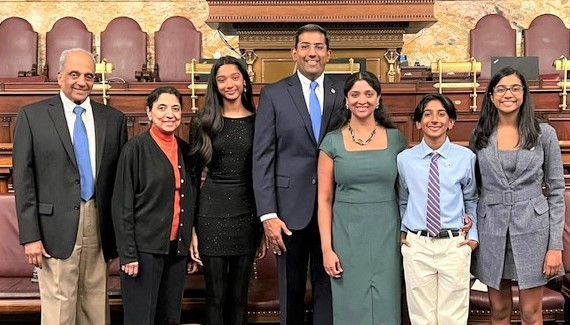
Dr. Venkat will head to Harrisburg to officially start his term in early January. When discussing what his early days will look like, a few things came up. First, the state house flipped control from Republican to Democrat (Democrats: 102, Republicans: 101). However, there are now three vacant seats from representatives who either moved to higher office or unfortunately passed away before the term began. As a result, there will be special elections for these seats. Dr. Venkat feels that it is imperative that these elections happen early so that each district has representation in the state house. Another Indian American, Bhavini Patel, has announced her candidacy to fill the vacancy in one of these open State House seats. If you live in that region, please look out for her, and learn about her work.
Once Dr Venkat is in office, he hopes to advocate for funding for early responders, investments in public education and childcare, policies around affordable and accessible healthcare, preserving reproductive rights for women at the state level, and expanding access to the ballot box through methods like early in-person voting.
While we as a country are often drawn to national elections, it is the state and local levels that closely affect our daily lives. Whether school board elections, county commissioner races, or others, these local elections require the same energy, turnout, and attention to make sure our voices are heard in the political process. Arvind feels excited that it is trending upward – in 2014, voter turnout was 30% nationwide, but this year it was 70% in his district — imagine if we only could inch closer to 90% to get elected leaders that represent all our voices.
It is with love, care, and support from the South Asian community, and communities at large, that Dr. Venkat ran in this race. He says he is a product of this community – his wife grew up here, they moved here, and they are raising their family here. As a community, it is imperative that we are engaged in the political sphere and make our voices heard – whether by supporting candidates, voting in every election, or running for office. We have the opportunity to share the values our families brought to the US and make this country even better for the next generation. Dr. Venkat is the first Indian American in this position in Harrisburg. He is confident and excited that he will not be the last. And so are we. ∎
The Way We Elect Our Leaders Is Not Reassuring
Posted by admin in January 2023, Past issues on January 12, 2023
By Kollengode S Venkataraman
There is widespread belief that American voters judiciously elect their leaders after evaluating their candidates and the issues they confront in national elections. This is because globally, the United States’ history in electoral politics has gained mythical dimensions, eventually getting into high school textbooks in many parts of the world. However, we can make a case that American voters in the aggregate are not that discerning in electing their leaders. This is despite our long traditions in grass roots democracy since the days when the Pilgrims arrived in Massachusetts on the Mayflower in the 17th century. Our voters seem to follow their past voting patterns based on their beliefs, ideologies, deeply held anxieties towards change, even prejudices.
A more troubling pattern in the US is the sharp differences in the voting patterns among the urban, suburban, and rural populations. These groups live in silos, with little efforts to understand each other’s hopes, priorities, and anxieties. Worse still, they live with mutual disdain and condescension towards each other despite all the wonders of instantaneous communication and affordable gadgets for disseminating information. One can even make a case that the silos mentality is because of the instantaneous and affordable access to information, with well-funded campaigns that only reinforce people’s beliefs and prejudices.
This situation makes it difficult for building consensus to bring about changes with minimum discord. This is becoming a global trend in developing and less developed economies with ominous consequences.
In the 2022 midterm elections in Pennsylvania, we had “open seats” for the US senate and governorship, with the none of the GOP and Democratic candidates having the benefit of incumbency. For the US Senate, the candidates were Mehmet Oz (R) and John Fetterman (D); and for the governorship, Doug Mastriano (R) and Josh Shapiro (D).
Even though the seats were “open,” candidates Mastriano, Fetterman and Shapiro were not new to electoral politics in the state. Fetterman was the elected lieutenant governor for the retiring governor Tom Wolf, and Shapiro was the elected Attorney General, both having won in state-wide elections. While Fetterman and Oz won in the party primaries early in 2022, Shapiro was unopposed in the primary.
Mastriano too was not new to electoral politics: he is the state senator in Harrisburg for District 33 comprising Franklin and Adams counties, part of what is known as “the Dutch Country.” He won in the party primary for the governor’s office. Mastriano is a US army veteran (30 years), retired as a colonel after serving in Europe during the Cold War, and in the wars in Kuwait, Iraq, and Afghanistan.
The GOP US Senate candidate Mehmet Oz, a New Jersey native and a retired cardiothoracic surgeon, was a TV personality promoting health fashions in Oprah Winfrey’s morning shows. Oz was new to electoral politics—not having contested even in school board elections—and an “outsider” in Pennsylvania. But Oz had the backing of President Trump.
These “open seat” situations gave an opportunity to study the voting patterns in the “urban” Allegheny County (with Pittsburgh at the center) vis-a-vis the five surrounding suburban counties. See the picture below.
Fetterman (D) was a “local” candidate with an unusual background. He was born in southeast Pennsylvania to parents who were nineteen years old at the time of his birth. He was raised in affluent suburban York, PA and his parents were Republicans.
While Fetterman was studying at the University of Connecticut for his MBA, his best friend died in a car accident that deeply affected him. Later, Fetterman joined the NGO Big Brothers Big Sisters of America, pairing with an eight-year-old boy in Connecticut whose parents both died of AIDS. He worked for two years in Pittsburgh in risk management as an underwriter. In 1995, he joined the AmeriCorps, and was sent to teach Pittsburgh adults pursuing their GEDs, giving a second chance to people who did not complete high school. He later went to Harvard’s Kennedy School graduating in 1999 with a master’s degree in Public Policy. (Source: Wikipedia)
Fetterman is known in our region as the Mayor of Braddock between 2006 and 2019, a rundown municipality in the Mon Valley (once a thriving place in the heydays of Mighty Steel decades ago), now known for poverty, violence, and crime. His work in Braddock gave him national recognition.
With this background, Fetterman was seen by many as a shoo-in candidate for voters in our region, given that his opponent Mehmet Oz, a multimillionaire TV doctor was seen as a carpetbagger from New Jersey.
Oz, the son of Turkish immigrants, raised in Wilmington, Delaware, is a dual citizen of the US and Turkey. He went to Harvard University (biology undergraduate), and later to the University of Pennsylvania (medicine and MBA degrees). In 2001, he became a professor of surgery at Columbia University and was a well-recognized cardiothoracic surgeon. In the early 2000s, Oz was a regular guest on The Oprah Winfrey Show. In 2009, he started his own The Dr.Oz Show, a daily television program on health and medicine, running for thirteen seasons. Oz dabbled in alternative medicine, faith healing, and various paranormal beliefs that earned him criticism from a number of medical publications and physicians (Source: Wikipedia).
Given this contrast between Fetterman (D) and Oz (R) as candidates for the US Senate, I too expected that Fetterman would have no problem harvesting votes from our region of the six counties, namely the urban Allegheny County and the surrounding five suburban counties. But an analysis of the votes polled in the elections revealed something quite different and significant in US electoral politics. The voter data extracted for this story is from www.electionreturns.pa.gov/#
Historically in US elections, there are significant differences in the voter turnout between the quadrennial presidential elections and the biennial midterm elections. Therefore, comparing the voter data in the presidential elections with those in the midterm elections may muddy the analysis. Therefore, the results of the midterm 2022 are compared with those of the midterm 2018 elections. The table below shows the results of the 2018 and 2022 midterm elections.
In the 2018 midterm elections for the US Senate, Bob Casey (D), the incumbent US Senator, ran against congressman Lou Barletta (R), the GOP candidate for the US senate. Barletta too, like Oz, had the former President Trump’s endorsement.
On the statewide votes count (red letters at the top of the table), in the 2018 midterm elections, the Democratic incumbent Casey with 56% of the votes defeated Barletta who got 43% of the votes. In the 2022 election, the Democrat Fetterman, the PA native son, could defeated the outsider Republican Oz only with a narrower margin of 51% vs Oz’s 46%.
Incidentally, after nearly 80 years, Pennsylvania now has both US senators from the Democratic Party. The last time this happened was in the 1940s. In that sense, there is a big palpable change on the electoral politics in our state, partly attributable to the redistric https://www.msn.com/en-us/feed ting of electoral maps.
When we drilled down the voter data for the counties in our region, the numbers are quite revealing. Historically, the highly urban Allegheny County, as urban counties everywhere in the US, has always been heavily Democratic.
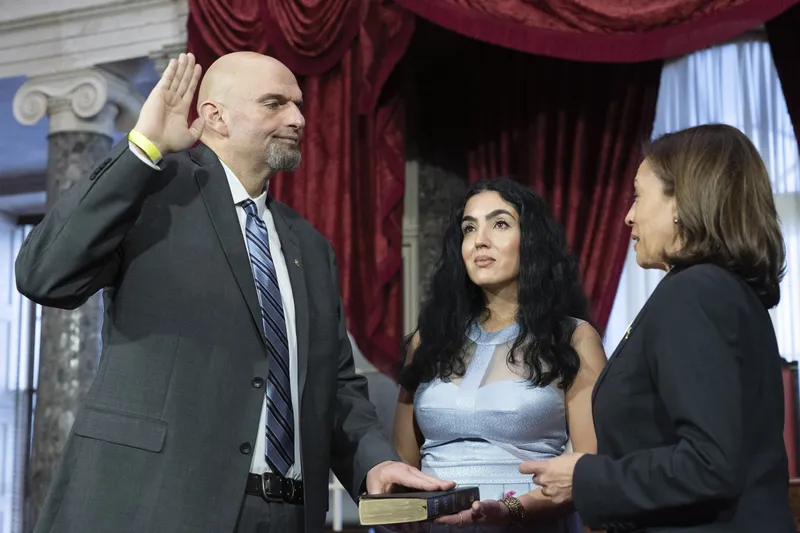
Therefore, in the 2018 Midterm (green part of the Table), in Allegheny County, the vote split between Casey and Barletta was 66/33. For Fetterman in 2022, the vote split against Oz was narrower, namely, 63/35. It is noteworthy that even though Fetterman is from our region with an impressive record, he got only 63% of votes in Allegheny County against OZ, an outsider from New Jersey, lower than Casey’s 66% of votes against Barletta.
Again, historically, all counties surrounding Allegheny County have always been consistently Republican, some more, some less. This is a common trend between the urban and the surrounding suburban counties in all fifty states in the US. Compared to the 2018 midterm, in the 2022 midterm elections, all the surrounding counties voted even more heavily Republican. See below:
2018 Midterm 2022 Midterm
Armstrong County: 63% GOP 69% GOP
Beaver County: 47% GOP 53% GOP
Washington County: 51% GOP 56% GOP
Westmoreland County: 55% GOP 59% GOP
Fetterman, a Harvard MBA, is a “native” local candidate heavily invested in the region, with an impressive track record, serving as mayor in one of the most depressed municipalities in our area. Even with such a record as Fetterman’s, the Democratic party still got a smaller percentage of the votes in the 2022 midterm against the GOP’s outsider Oz, compared to what the Democratic party got in the 2018 midterm race for the US Senate.
That is, irrespective of the merits and track record of the candidates and his/her political roots in our region, citizens here, in the aggregate, voted only based on their party affiliation, political ideologies and visceral Red-Blue identities, and deeply held beliefs and prejudices. The individual candidate’s qualifications, personal track records and roots in our region did not seem to matter.
In the gubernatorial elections too, the 2022 midterm was an “open seat” between Shapiro (D) and Mastriano (R). Both were in state elective politics, with Shapiro as the attorney general and Mastriano as a state senator in the General Assembly in Harrisburg. Both were “native” Pennsylvanians. See the table below for the voting data. It is noteworthy that in the two midterms, the percentage of votes the two parties got were remarkably close. In the aggregate, the votes the candidates received were more dependent of voter’s political ideologies and party affiliations between the GOP and the Democratic parties, and not necessarily on the candidates’ track records.
This pattern in political affiliation among people in urban counties (heavily Democratic) and suburban counties (heavily Republican) is seen throughout the United States. And when you add the rural counties into this mix, the interior rural counties tend to be even more Republican than suburban counties.
Another important feature in the US presidential elections is that many states have repeatedly voted for either the Democratic or the Republican presidential candidates. This is irrespective of who the candidates were, and no matter what the burning economic, military, foreign policy, or cultural issues at the time of election have been. See the table below showing how the states voted in the last ten presidential elections — over a 40-year period, nearly two generations.
Also, the population densities in urban counties are several times that of the suburban counties. Example in our region: Allegheny county’s population density is 1650/sq. mile, while that of neighboring Westmoreland County is 350/sq mile and that of Armstrong County is only 100/sq mile. The population densities in suburban counties, in turn, are orders of orders of magnitude higher than the population densities in rural counties (the population densities of Bedford, Bradford, Cameron and Clarion Counties are 50-, 50-,70- and 10 per sq mile.
The US has been the dominating force in the last 80 years in wealth creation, global politics, military might, sports, entertainment, R&D, higher education, and communications and electronic news media… … Not only the outside world, but even Americans themselves—at least a large cross section of Americans—seem to believe in what has come to be known as American Exceptionalism. Hence there is widespread belief in Asia (and in Africa and Latin America) that Americans, with their grassroots tradition in electoral democracies make judicious choices in electing their leaders.
However, American voters in the aggregate, as shown in this analysis, are not as discerning as they are believed to be in electing their leaders. This despite their long traditions in grass roots democracy since the days when the Pilgrims arrived in Massachusetts on the Mayflower in the 17th century. They seem to simply follow their past voting patterns based on their beliefs, ideologies, even visceral fears, and prejudices.
A more troubling pattern in the US is that the urban, suburban, and rural populations live in silos, with little effort to understand each other’s hopes and anxieties; and worse still, with mutual disdain and condescension towards each other. This is makes it difficult to build a consensus needed to bring about changes with minimum discord. These three groups could as well be living in different countries and cultures. ∎
A Bentley “Stolen” in London Found in Karachi
Posted by admin in October 2022, Past issues on September 25, 2022
A bizarre story indeed: A Bentley Mulsanne luxury vehicle costing over $200,000, allegedly “stolen” from London was found in Karachi’s upscale Defence Housing Authority (DHA) residential area, originally developed for high-ranking retired Pakistani military officers. Many retired officers sold their homes at HUGE profits to private citizens.
In September 2022, the Customs Office in Karachi received a tip from a “friendly country” on the precise location — the street address in the DHA complex — of the Bentley. When Pakistan’s customs officials went to the upscale house, lo and behold, the Bentley was in the parking garage. In a story in Dawn, Imtiaz Ali reports this:
The officials asked the ‘owner’, Jameel Shafi, to provide the title for the vehicle. Instead of producing the papers, Mr Shafi stated that the vehicle was sold to him by one Naveed Bilwani with the agreement that Mr Bilwani would bear all liabilities to clear required documents from authorities before November 2022. As the “owner” could not produce the document of the vehicle, the customs department took possession of the vehicle.
Later, during investigation, Bilwani informed officials that he had only helped broker a deal between Shafi and another person named Naveed Yamin as a guarantor of payment and papers and Mr Yamin received cash from Shafi as payment against the vehicle.
n a later story Dawn tells that the 2014-model Bentley was imported in 2019 by the Bulgarian ambassador to Pakistan, who later sold it to a Pakistani, which is illegal because it circumvents a whopping 300% import duty for such luxury vehicles. A whole bunch of government officials in Pakistan’s customs department, DMV and other agencies are now caught up in the scandal. Once so many government officials are involved in a scandal, as it happens in that part of the world, nobody will be held accountable.
The expensive car had a microchip installed to track its location. If only any one of the people in this scandal knew to deactivate the microchip, this scandal would not have exploded the way it did.
London’s British Museum displays artworks the empire stolen from India during its colonial occupation. One wonders if Pakistan would remember this and keep the Bentley for display in Karachi or Islamabad. ∎
Book Review: Dhananjay Joshi’s “No Effort Required”
Posted by admin in October 2022, Past issues on September 25, 2022
No Effort Required is the English translation of Dhananjay Joshi’s articles in Marathi, serialized under the title Sahaj in Lokamat, the Marathi daily. The word सहज, taken straight from Sanskrit, means born with, natural, effortless, or congenital. Arun Jatkar, known to our readers, and a cousin of Joshi’s, translated the series into English.
The theme of this book is the author’s reflections on his decades-long spiritual quest on the purpose and meaning of life. This takes him from his cultural moorings in his traditional Hindu upbringing and interactions with family elders like his grandmother and several teachers in India. This search continued through his engineering education in Poona. Later, when he came to the US for higher education at the Illinois Institute of Technology in electrical engineering and mathematics, his quest continued. He had long interactions in the US with the monks at the Ramakrishna Math and with Zen masters from Korea and Japan.
As many Hindu/Jain/Buddhist/Sikh teachers in India have repeatedly advised us in each generation, tranquility and freedom (Moksha in Sanskrit) are to be realized here and now when we are alive, and not in Swarga, Heaven or Jannat, post mortem — I use post-mortem in the literal meaning of the phrase, namely, after death. This idea is also central to Buddhist teachings all over Asia.
The author’s spiritual journey continued while he was living in Chicago, starting his career in corporate America, with him organizing meditation retreats in his rented apartment. And later, leading life as a married man, paying taxes and educating his children. He did not run away to the foothills of the Himalayas between career transitions, or out of disillusionment in life in the US. When people are predisposed to these kinds of pursuits, they get — or find — their teachers, even in Chicago, even in the midst of all the regular grinds that overwhelm most of us.
Serious English readers in India — the book’s target audience since it is published there — are in a hurry, used to rapid reading. The short, easily readable stand-alone stories in the book are suitable for these readers. However, just because the articles are short and readable, it does not mean that readers can absorb their central messages in rapid reading. Several articles in this collection, described as “pointillist” by Margaret McKenzie in her foreword, are cryptic and end abruptly. If readers do not pay attention in their speed reading and do not pause at the end of each story, they may altogether miss their import.
This pointillist style of the short pieces, each standing on its own has a long history in Indian literature. Examples are the one hundred verses in Vedanta Dindima (attributed to Adi Shankara, perhaps incorrectly), or the 1330 couplets in the 2000-year-old Tamil classic Tirukkural. These individual verses are like bananas in a cluster, each complete by itself, independent of others in the bunch.
Many of the lessons the author learns from his Zen masters are the same that the Hindu tradition teaches, namely patience, frugality, simplicity, honesty (to oneself) in one’s life and lifestyle, and diligence, persistence, efforts, and dispassion in one’s pursuits.
On reading the short pieces in the book, spontaneously I recalled the great line मन एव मनुष्याणां कारणं बन्धमोक्षयोः (Mind and mind alone is the cause for both the bondage and liberation of man) from the Amritabindu Upanishad, or अभ्यास-वैराग्याभ्यां चित्तवृत्ति निरोधः (With practice and detachment, a vacillating mind is quietened.) from Patanjali’s aphorisms.
Another lesson that comes out in Joshi’s writings is what is stressed in traditional Indian teachings, namely, the importance of right motivations in our pursuits. Even if we pursue the right course of action, but with the wrong motivations, we are advised, we will be dissatisfied with the outcome. And even when we pursue seemingly unpopular and unproductive objectives, but with the right motivation, eventually we will come out OK.
The stories are easily digestible, but are difficult to read because of the small font size and tighter line spacings. The publisher could have fixed this since there are wide margins on the left-hand-side pages in the book. And there are random distractions of missing spaces between words, a feature that was easily fixable with today’s editing software. But for these features, the book is worthy of reader’s’ time since it addresses in a contemporary style and context many issues young professionals face.
No Effort Required Author: Dhananjay Joshi, Translation: Arun Jatkar, Publisher: Rohan Prakashan, 155 pages. Pune, India. INR 300.00
Reviewer: Kollengode S Venkataraman ∎
Continuing Education at CMU for Seniors in Retirement
Posted by admin in October 2022, Past issues on September 25, 2022
By Sankar Seetharama, Pittsburgh, PA
One of the best kept secrets in the Pittsburgh metropolitan area, the Osher Lifelong Learning Institute at Carnegie Mellon University (CMU), offers its members, primarily the senior community, opportunities to expand their knowledge, enhance their skills, interact with their peers, and increase their social and cultural awareness. It provides members a range of short-term, non-credit courses, lectures, and field trips, taught by faculty from CMU and other institutions, retired business professionals and representatives from community organizations, all eager to share their knowledge and expertise.
In August 1991, Robert Mehrabian, Carnegie Mellon University President, brought in Steve Calvert as assistant VP and director of alumni relations to found an adult education program. Mehrabian’s vision was to strengthen alumni relations, including a focus on education programs for alumni and the University’s neighbors, primarily retired adults still thirsty for knowledge.
Guided by Gretchen Langford, a Margaret Morrison Carnegie College alumna, and Edwin “Ted” Fenton, alumnus, Director of CMU’s Center for University Outreach, the Academy for Lifelong Learning (A.L.L.) came to be in 1992. In its first year (1993-1994), it drew three hundred students.
By 2007, A.L.L. had grown to over 1,200 members. Following a grant from the Bernard Osher Foundation, the A.L.L. Board of Directors recommended joining forces with the Osher Lifelong Learning Institutes, dedicated to the same goals. By early 2009, Osher at CMU had new offices in Hunt Library, two classrooms in Wean Hall, a website, and an endowment from the Osher Foundation.
Now all of these have been consolidated in a lovely new Learning Center in Cyert Hall on campus funded by the Osher at CMU and local foundations. Osher, not part of CMU, is an independent, 501(c)3 non-profit organization. Most importantly, it is volunteer-driven. From the Board of Directors to its committees and its instructors, everyone is a volunteer. It helps reinforce a sense of community. There is also a dedicated staff, responsible for running the show. Led by an Executive Director, they produce course catalogs, schedule courses, maintain the website, help with registration, and take care of all the business aspects of the organization.
Each year, members can choose from over four hundred courses, covering an incredible range of subjects from the study of a Shakespeare play to under-water photography, secrets of Pittsburgh, architecture, Indian history, music, personal finance, legal issues, health & wellness, and much more. Most of these classes are taught in the Learning Center in Cyert Hall.
Beginning in August of 2019 Osher’s Executive Director and then President had a series of meetings with Chatham University’s President. These meetings led to the Lifelong Learning Program partnering with Chatham University offering courses at their Eden Hall Campus in Gibsonia, PA providing closer access for residents of surrounding communities.
During the COVID-19 pandemic, all classes were held on Zoom®. Some classes will be offered on Zoom in addition to the in-person classes to accommodate those unable to attend classes on campus.
Osher at CMU is always happy to welcome new members & instructors! Check us out at www.cmu.edu/osher/ ∎
============================
Aishwarya, daughter of Gopal & Sasikala Krishnamoorthy of Monroeville, PA and a student of Kamala Reddy, had here Kuchipudi rangapravasam on Saturday, June 25, 2022, at the S.V.Temple auditorium in front of a large number of invitees. Aishwarya learned the artform for over ten years, during which she was part of Kamala Reddy’s many Kuchipudi dance-dramas.
At Gateway High School, Aishwarya was part of the marching band and learned to play on the trumpet. At school, she received the Noah Gray scholarship for her commitment and achievements in the band. Graduating this year from Gateway High School, Aishwarya is now a freshman at University of Pittsburgh, pursuing engineering. ∎
Obituary: Manjeri Raman — A Life Well-Lived (1942 to August 4, 2022)
Posted by admin in October 2022, Past issues on September 25, 2022
By Som Sharma, Monroeville, PA
Manjeri Raman, known as Jeri to his colleagues and friends, who lived in the Pittsburgh metro area for decades before moving to Savannah, GA, died on August 4, 2022. The cause of death was complications from esophageal cancer.
He graduated in chemical engineering from the Alagappa Chettiar College of Technology in Chennai in the early 1960s. He came to the US in 1967 for his graduate studies in chemical engineering at the University at Buffalo in the SUNY system. Krishna, whom he married in 1970 in Chennai, India, joined him later.
Manjeri’s long career in marketing was with Spencer-Kellogg (Buffalo, NY), Calgon Corporation (Pittsburgh, PA), and SNF Holding Co. (Riceboro, GA). With his easy-going disposition in working with people from diverse backgrounds and his natural leadership skills, he rose to senior positions. In retirement, he worked as a marketing consultant. He traveled extensively, both domestically and internationally for work.
I first met Manjeri and Krishna as curious students of Advaita Vedanta during Swami Chinmayananda’s first visit and Jnana Yajna in Pittsburgh in 1978. He was drawn into the Chinmaya Mission’s activities. With him and many others, we organized several week-long lecture series on the Gita and Vedanta topics by Swami Chinmayananda himself and by other monks of the mission. A special one was the Chinmaya International camp at the Slippery Rock University in 1984, when we rented the entire campus for 10-days, a one-of-a-kind event then. We travelled together to many Chinmaya spiritual camps in other cities. In Savannah, he started the Chinmaya Satsang, which is quite active today, with participants both of Indian heritage and from the American mainstream.
He was in the S.V.Temple’s governing bodies, where he was known to run committee meetings and participate in them with great elan.
Manjeri was cosmopolitan and open-minded and had a unique gift of making everyone feel special. He was comfortable with his circle of friends from diverse Indian linguistic and sub-cultural groups, as well as other nationalities and races. He did not let his vulnerabilities get in the way of learning or seeking help from others in any aspect of his life. Raman and Krishna loved to travel, going to many tourit and pilgrimage sites.
He volunteered with Hopelink in Redmond, a Seattle neighborhood in Washington state. He also tutored fifth graders in math at Gould Elementary School in Savannah.
Raman was a voracious reader with interests in politics, society — he admired Mahatma Gandhi — and football, tennis, golf and, of course, cricket. He was an avid tennis player and a golfer. He loved Karnatic music and light entertainment movies in Indian languages. A loving and caring partner and father, Raman was a friend, philosopher, and guide to his children Anandi and Arvind. He was fond of his wonderful life partner, Krishna, a courageous and independent woman in her own right, for fifty-two years.
A storehouse of information, a loving and caring partner and father, a sports enthusiast, a spiritual seeker, a “servant leader,” a trusted, large-hearted friend, a conscientious citizen, a fun-loving and easy-going guy, a man of conviction, yet respectful of opposing viewpoints — an almost perfect human being. A life well lived. The mortal remains of Raman were cremated in Savannah, with his adopted son Arvind doing the last rites for him. Later, his family organized a memorial gathering for Manjeri on Friday, September 9, in Savannah, where a large number of his friends from different cities gathered to reminisce and celebrate his memory. ∎
The Raghupathis Move to San Diego After Their Four Decades of Active Life Here
Posted by admin in October 2022, Past issues on September 25, 2022
By V. Vasudevan, Monroeville, PA
Janaki and Narasimhan Raghupathi, known to many among the Indian diaspora here, and very well-known people associated with the S.V.Temple, moved to San Diego last July after their over four decades of productive years living amongst us. They moved to San Diego to live close to their son and daughter there.
Janaki arrived in Pittsburgh in the early 1970s to pursue her master’s program in structural engineering at the University of Pittsburgh, after graduating in 1971 from the Indian Institute of Technology, Madras in civil engineering. In the mid-1960s, she was one of the very first “girls” to enter the IIT to pursue the coveted BTech in engineering. One of the reasons she chose Pitt was that her fiancé Narasimhan Raghupathi was pursuing his PhD in Chemical Engineering at Pitt.
After their marriage, they had a brief stint at Ford Motor Co. in Detroit before moving back to Pittsburgh to spend over four decades here.
Janaki spent all her working years at the Westinghouse Energy Center in Monroeville and Cranberry in various capacities in structural engineering projects related to nuclear power plants.
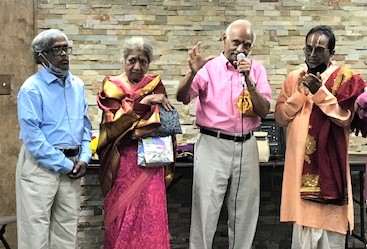
Her background in civil and structural engineering came in handy at various stages of finalizing the plans for the S.V.Temple that was consecrated in 1976. Her volunteer work at the temple continued in various roles in planning many one-of-a-kind festivals and procuring a variety of unique supplies against deadlines from all over the world in the pre-Internet, pre-Amazon, and pre-Walmart days.
Janaki was there to help anyone at any time, whether it was for arranging arangetrams, marriages, and hosting visiting artistes; or helping people in medical and any other type of emergencies. There was no end to the selfless and tireless work she did for all who approached her.
Raghupathi, her husband, on the other hand, is quiet, complementing Janaki’s gregariousness. Often, he introduced himself as Janaki’s husband. He did his master’s in chemical engineering from VJTI, Mumbai and earned his PhD in ChemE from Pitt. After his brief stint at Ford in Detroit, he joined PPG working in various capacities in managing projects. He travelled widely for work, meetings with customers and vendors. He regaled with stories on his visits to Moscow and other cities in the Soviet Union during the collapse of the USSR. He too was associated with the S.V.Temple management in various official capacities.
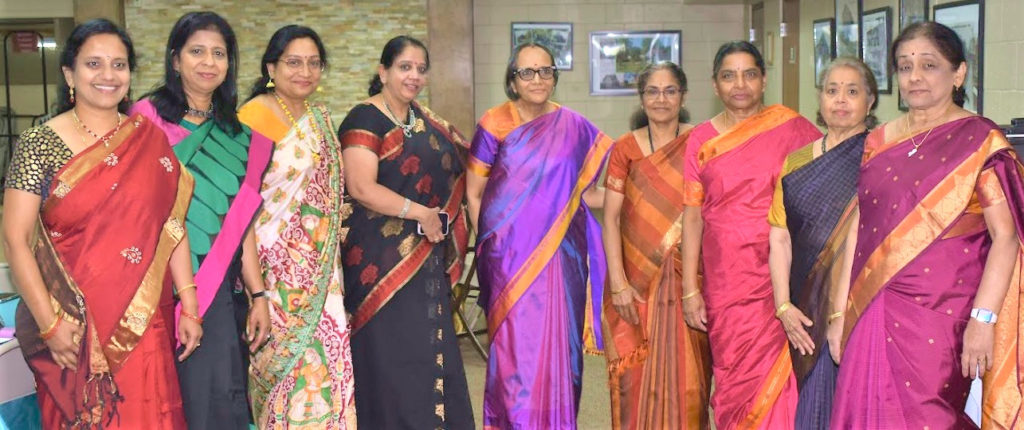
Raghupathi has been the unofficial tax consultant for the priests and office staff at the temple from the time the temple started, making sure that they got all the applicable deductibles and refunds. He also made sure that they also set aside money for their retirement.
The friends of the Raghupathis organized a farewell party at the Murrysville Community Center on July 8, 2022, where they recalled fantastic stories and anecdotes in their interactions with Janaki and Raghupathi. While all their friends miss their presence here, I join them wishing Janaki and Raghupathi well in their retirement with their two children in the sunny San Diego, enjoying their life living close to the beach, the mountains, and the desert. ∎

